

Catamarans vs. Trawlers: The Differences Explained
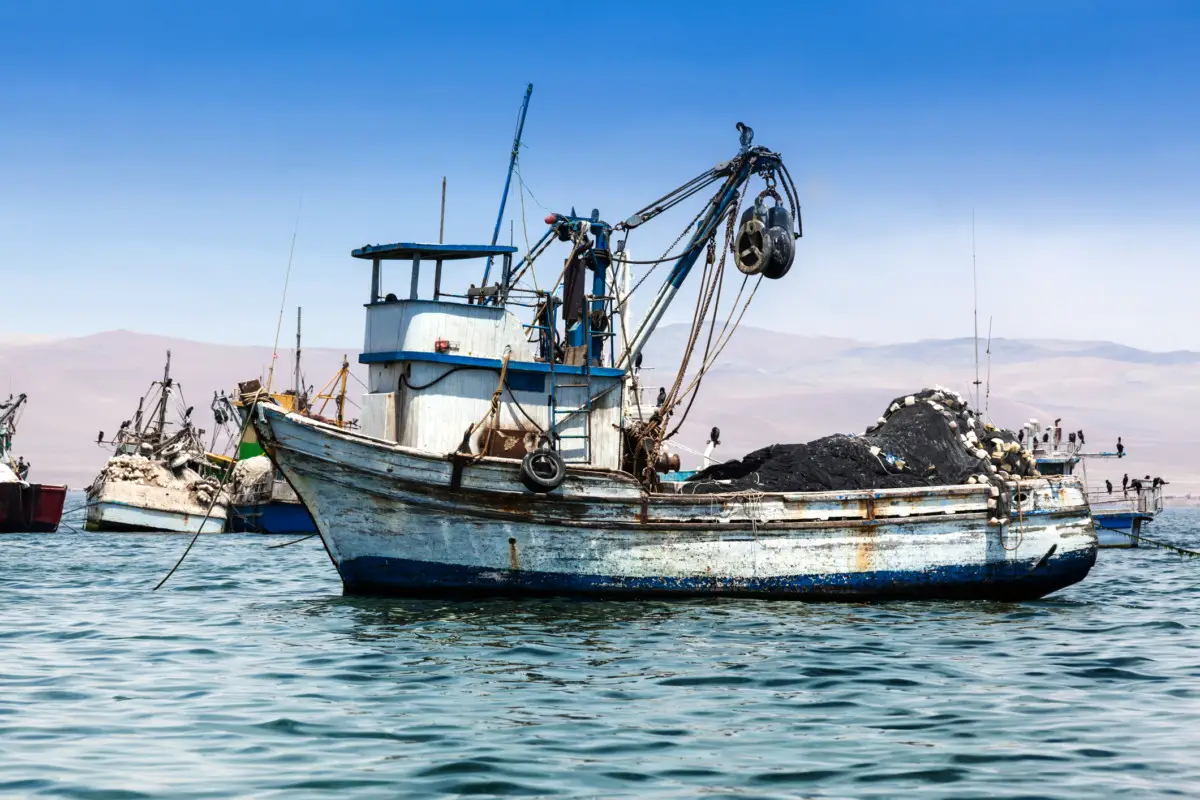
As an Amazon Associate, we earn from qualifying purchases. We may also earn commissions if you purchase products from other retailers after clicking on a link from our site.
Catamarans and trawlers are two vessels ideal for your sailing adventure. But while they are both great boats, they have different characteristics and therefore are more or less suited for specific tasks. So what are the differences between the two, and which one should you opt for?
Catamarans are double-hulled yachts that come in both sail and power editions (two diesel engines). Trawlers are single-hulled displacement boats powered by one diesel engine. Trawlers have better loading capabilities but cats are faster and more stable.
For anyone not very familiar with boats or sailing, it can be challenging to decide on the best-suited boat for your sailing needs. Fortunately, in this article, we explore the differences between catamarans and trawlers as well their pros and cons. Stick around to get all the information you need to choose your ideal sailing companion.
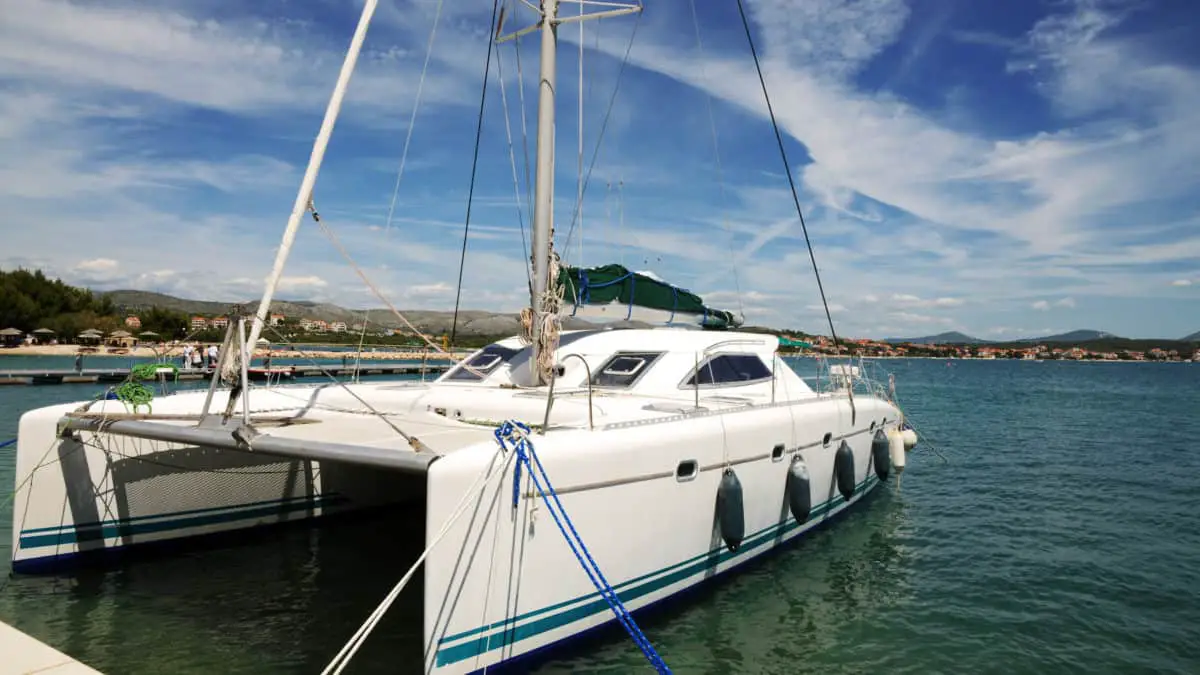
What Are Catamarans?
Catamarans are sailing vessels with double hulls and a deck in between (known as the bridgedeck ) connecting the two hulls. These sail or engine-powered boats are quite popular with leisure and sport boaters because of their elegant style, sleek designs, superb performance, versatility, and comfort.
Catamarans come in all shapes and sizes, from the tiniest beach cats you can lift with a friend or giant 70ft luxury ships worth millions of dollars.
These boats date back to the early centuries. They started off as simple fishing rafts made from bound tree trunks and were favored vessels throughout Polynesia and Micronesia. The modern catamaran is a modification of this unique, ancient design. By the 20th century, catamarans were full-fledged yachts, competing in races against mono-hulled boats.
Catamarans: The Pros
Let’s have a look at some of the advantages of catamaran boats.
Catamarans Deliver a Superb Performance
Catamarans are pretty fast. This is because their water length is double that of traditional monohulls. They are also light in weight since they lack lead keels – which typically weigh hundreds of kilograms. Cruising cats average around 10 knots (18.52km/hr or 18,520m/hr) with top speeds of about 15 knots (27.7km/hr or 27,700m/hr).
How fast can a catamaran sail?
While the structural design of most charter catamarans tends to focus more on space than speed, modern performance catamarans are quite the opposite. The latter can cruise 25 – 50% faster than similar-sized monohulls.
Their excellent performance is one of the main reasons why these boats are so appealing. Still, heavy loads tend to weigh them down. Thus, an overloaded cat will be much slower.
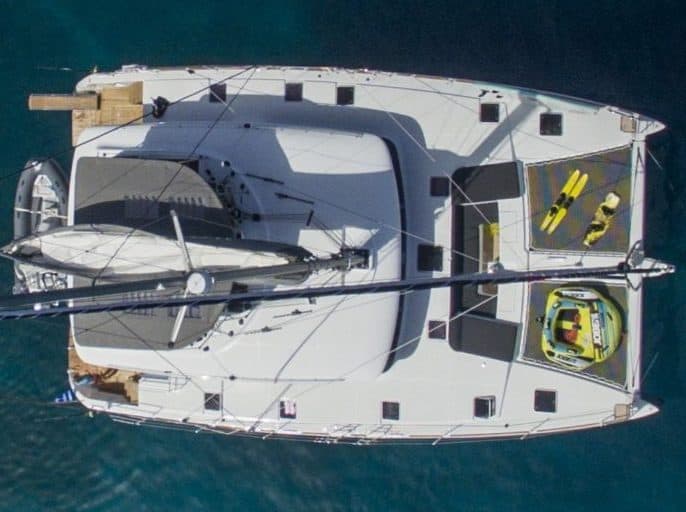
Catamarans Are Very Stable
Catamarans are stable flat platforms both offshore and at anchor. A cat’s stability comes from its wide beam since, unlike a monohull, it doesn’t have a ballasted keel. The cat’s flat plane and natural stability make it highly suitable for a family looking to enjoy their holidays in maximum comfort. It is also ideal for scuba diving holidays since divers can gear up, enter or exit from the water with ease.
Additionally, by minimizing the level of wave-induced motion, the twin hulls boost the catamaran’s balance and stability. What this means is that you are less likely to suffer motion sickness on board a cat.
Motion sickness on a cat?
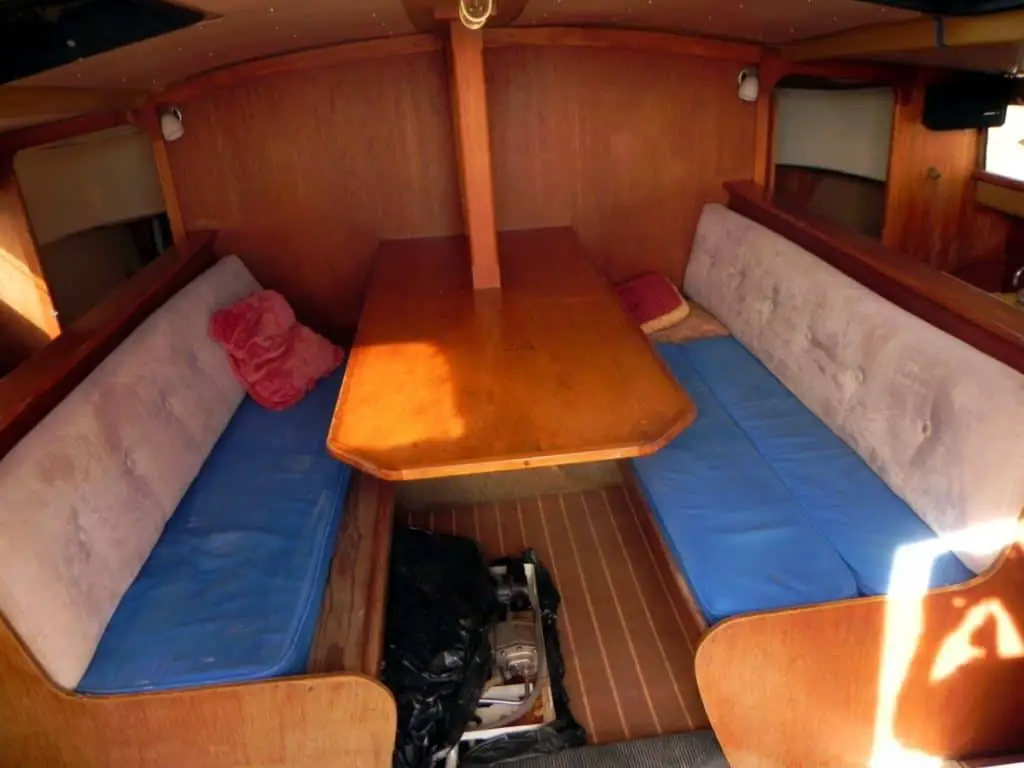
Catamarans Have Lots of Space
Catamarans are spacious boats. The space between the two hulls provides ample living room to fit a dining area, lounge, and a spacious kitchen for preparing your meals. The yacht’s back and front regions also offer additional lounging areas. With the varied relaxation areas, you get lots of privacy onboard a catamaran.
Double hulls translate to additional privacy since the cabins are separate. Furthermore, each hull typically comes with its own separate entrance. This feature makes catamarans well-suited for couples, families, or groups of friends. They also find the ample deck space and overall comfort quite appealing.
Larger families will also find a catamaran very convenient. While the cabins’ size varies depending on the catamaran model, they are generally spacious and comfortable.
What’s the perfect boat layout for you?
Catamarans Are Comfortable
Catamarans do not heel. Their wide stance on the water reduces heeling, wave-induced motion, and may also contribute to reduced wakes. What this means is that cats are pretty comfortable both while underway and at anchor. You can take a stroll on deck with ease and enjoy a drink without worrying about spilling its contents on yourself.
These features make cats ideal for families with young ones or elderly grandparents who might not be too steady on their feet.
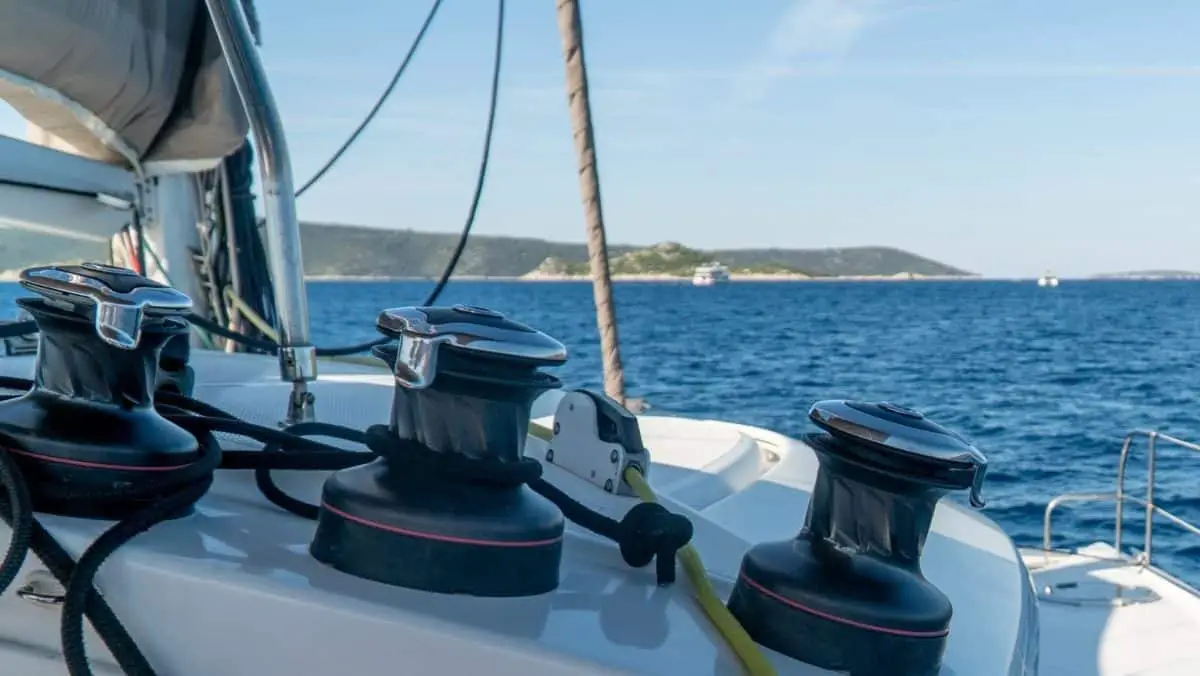
Catamarans Are Easy To Handle
Balanced hulls and twin engines make catamaran vessels significantly easier to operate than monohull yachts. Manoeuvering into narrow marinas becomes simpler and more straightforward too. This fluid maneuverability allows those with sailing experience to sail a catamaran single-handedly.
Is sailing a catamaran hard?
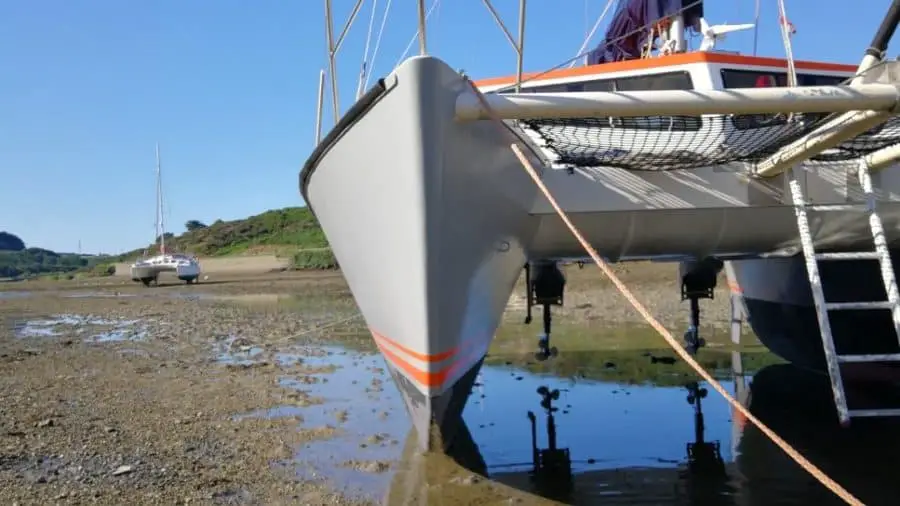
Catamarans Can Get Into Shallow Waters
When compared to monohulls, catamaran vessels have lesser volume, lighter displacement, and shallower draft. With less of the boat below the water, it means that you can pull the boat into shallow water without worry. This enables you to anchor much closer to the shore, where it’s safer, better protected, and more comfortable for anchoring.
Most catamarans can even go all up unto the beach !
Catamarans Use Less Fuel
A catamaran’s twin-hull design causes it to have low hydrodynamic resistance. As a result, the boats tend to use less fuel because they don’t require much sail or motor power to get them moving forward. This makes catamarans more economical to run.
Catamaran fuel efficiency
Catamarans Are Extremely Safe
It’s almost impossible for a catamaran to sink. The thing is, modern cruising catamarans consist of lightweight builds of foam construction, making the boats virtually unsinkable. This feature alone accords any sailor a high level of offshore safety, not to mention peace of mind.
When do catamarans capsize?
Catamarans: The Cons
Catamarans are great vessels, but they have their downsides. Let’s have a look at a couple of them.
Catamarans Are Expensive
Buying or chartering a catamaran is expensive. At times, the rates could go up by more than double the cost of similar-sized yachts. However, cats provide great value for money due to their unrivaled comfort, space, and flexibility. As such, when going for a sailing holiday, it makes great economic sense to opt for a catamaran.
Cats are also expensive to maintain. Two engines, two hulls, two rudders, multiple sails, and rigging translate to high maintenance and repair costs as there’s always something that needs fixing.
Why are catamarans so expensive ?
Catamarans Have High Marina Fees
Due to their great width, the rates charged in most marinas often go as high as 150% more than those for sailboats of a similar length. It’s also more challenging to find space in the marinas since cats require double spaces – try finding 2 empty slips right next to each other in a crowded marina. Worse still, some docks are not able to accommodate large-sized catamarans.
Note that catamarans are highly popular vessels, hence marina slots are usually limited due to the high demand. So, in the face of this serious challenge with space availability, it’s advisable to book the marina long before you come.
Catamarans Don’t Sail Upwind As Well
Catamarans find it difficult to sail too close to the wind. And some don’t point to the wind as well as monohulls, so they sail with a larger angle. Fortunately, most cats can sail pretty fast when on a reach. Therefore if you happen to fall a couple of degrees off, you can catch up with a monohull if you speed up. This is despite having to cover more ground.
How to sail a catamaran upwind
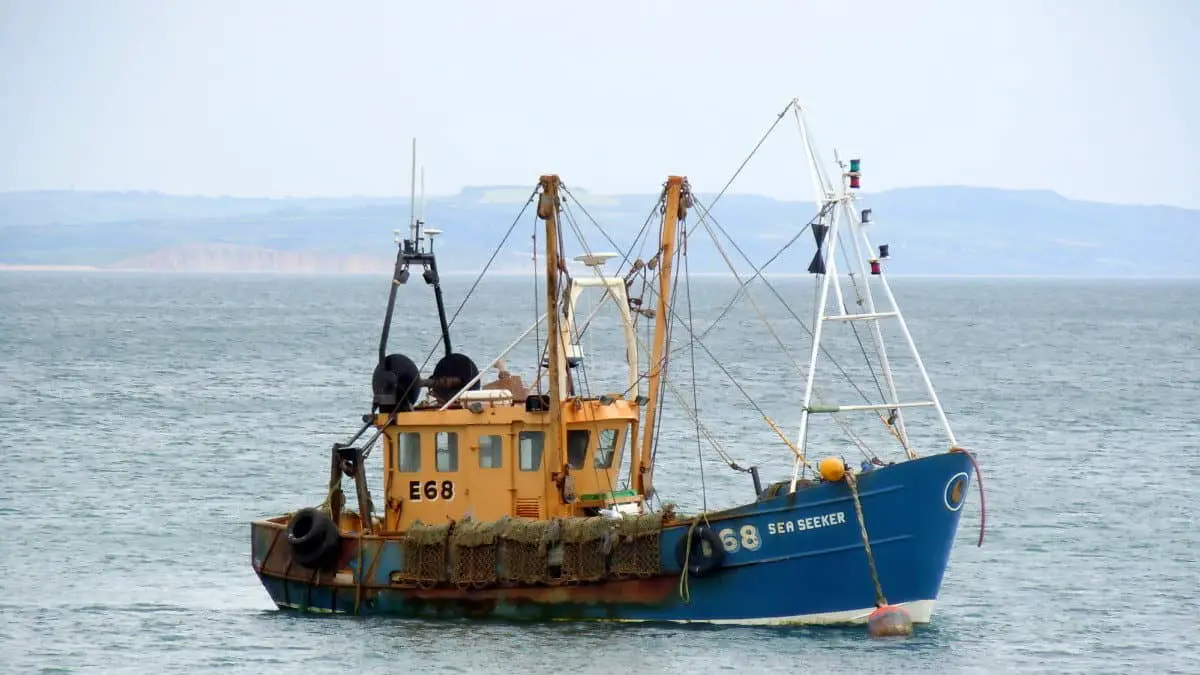
What Are Trawlers?
Trawlers are unique powerboats built for long-range leisurely cruising. They are also known as cruising or recreational trawlers . Many boaters live aboard these vessels for a long time as they move from one port to another. Trawlers originated from vessels used as commercial fishing trawlers; hence fishing trawlers and trawler yachts form the main types of trawler boats.
Fishing trawlers are the most common kind of trawlers. Built for fishing, they are popular with fishermen who use them to drag huge trawls (fishing nets) through the waters, capturing fish. However, they run at slow speeds to accommodate these fishing nets dragging across the water.
Recreational trawlers appeal to sailors who enjoy going on long-distance cruises but at a much-reduced pace. During winter, many retirees sail south down the intercoastal waterway and head back for the summer. And since speed is not the focus here, trawlers cruise at a slow and leisurely pace to their regional or worldwide destination.
Also, trawlers are versatile boats suitable for a wide range of activities such as day or night cruising, offshore boating, fishing, and sailing.
Cruising trawlers have well-laid out private staterooms, full galleys, and spacious saloons. These boats typically range between 35 and 60 feet (11 and 18 m), and most come with a single-engine, a displacement hull, and a raised pilothouse or deckhouse. However, it’s possible to find trawlers that sport two engines.
Trawlers: The Pros
Here are some benefits of using trawlers :
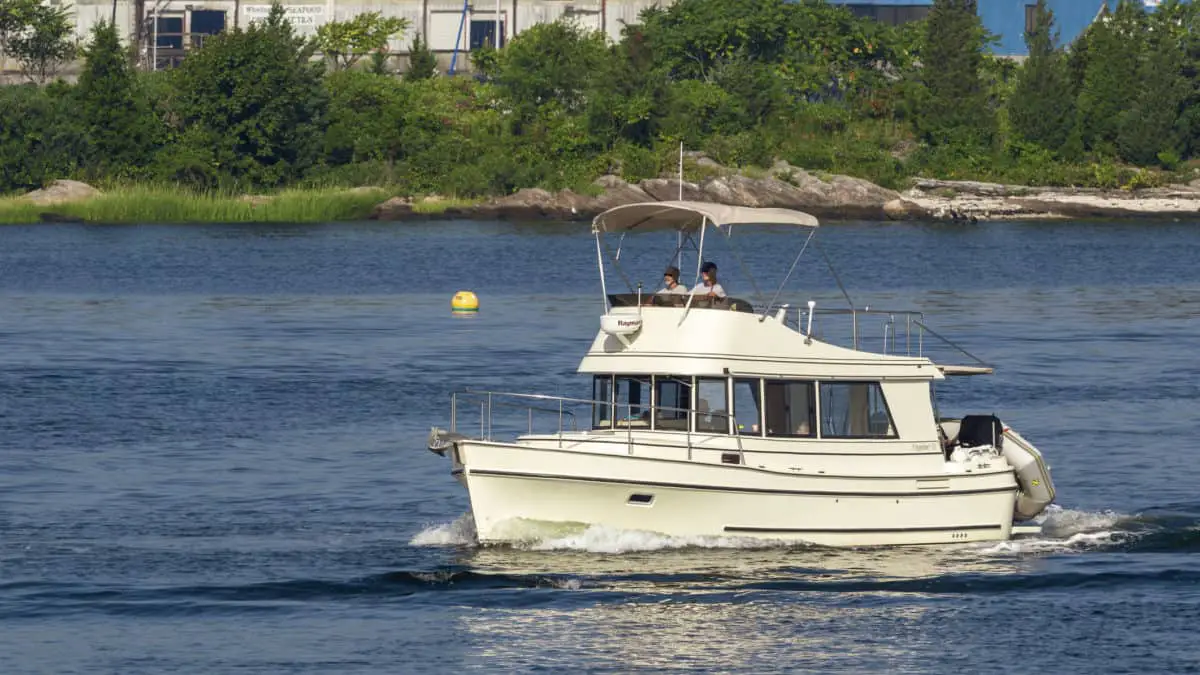
Trawlers Are Comfortable
Recreational trawlers are built for a comfortable and luxurious life on board. To this effect, they come equipped with fine staterooms and other creature comforts. The boats are super comfortable during calm conditions though they tend to roll from side to side in choppy seas.
Trawlers Have Big Living Spaces
Trawlers make superb family yachts and are excellent for entertaining guests. Below deck, they play host to large living areas that include a pilothouse, accommodation, a freezer hold, and big open galleys with ample headroom. The large windows brighten the interior while making it easy for parents to keep an eye on the kids while they play.
The boats also have lots of counter space, which means preparing meals for your family and friends is super easy. On the deck, the enormous flybridge offers unobstructed views and additional seating.
Due to their massive size, trawlers can comfortably fit 2 to 8 people for several days. What’s more, they can even make a permanent home.
Trawlers Have Considerable Storage Space
There’s no need to pack light on board a trawler boat since the available storage space is more than adequate. In addition to the standard closets, cabinets, and under-seat storage areas, trawlers also come with an enormous engine room that’s great for storing your spare parts.
There’s also extra room to store your stuff in the bow locker, beneath the top deck seats, and underneath the steering station.
Trawlers Have Two Helm Stations
Trawlers boast two helm stations: one in the interior and the other placed on the outside. The flybridge presents a favorable steering location, but during foul weather, you have the option of steering the boat from inside, away from the elements. The flybridge also enables you to catch spectacular views of the water when underway.
Trawlers Have Strong Weight Carrying Abilities
Unlike catamarans, which are pretty sensitive to weight, trawlers are designed to handle lots of weight. You can thus load up your boat without worrying about dampening its performance. In fact, you can even tow a large dinghy with trawlers.
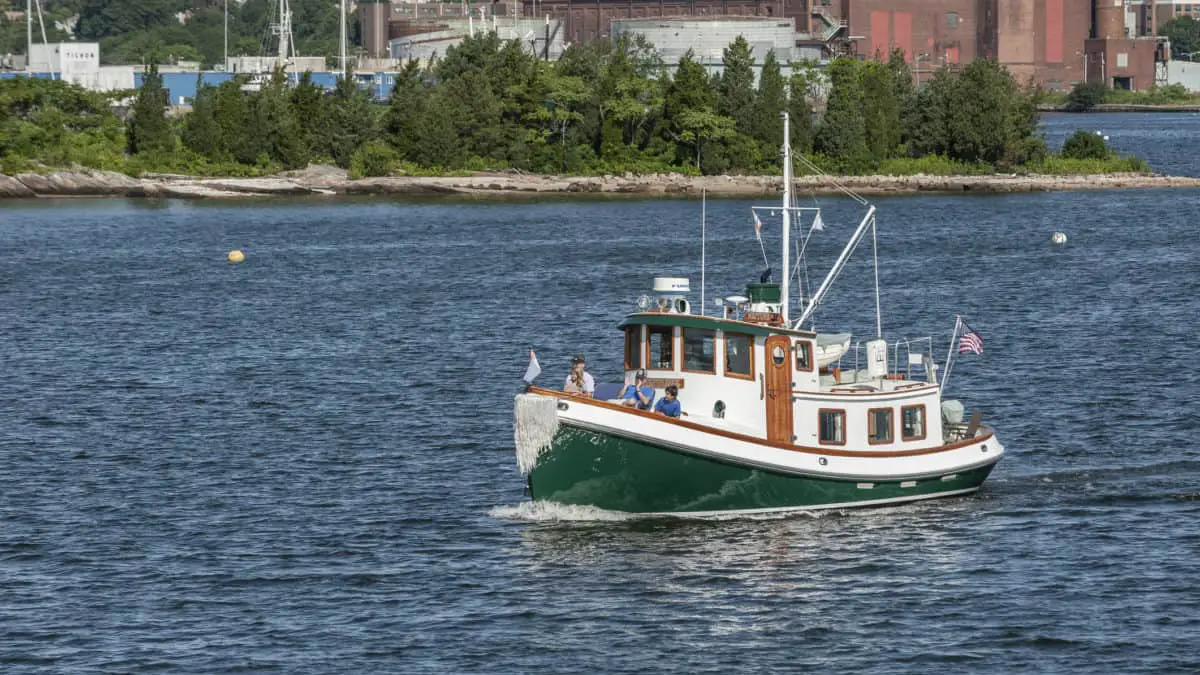
Trawlers Are Economical
Because trawlers have a large fuel capacity and a small, fuel-efficient engine, they can cruise for long distances without any need for refueling. This feature, along with the slower speeds of a displacement hull, allows these vessels to have greater range and fuel economy than other powerboats.
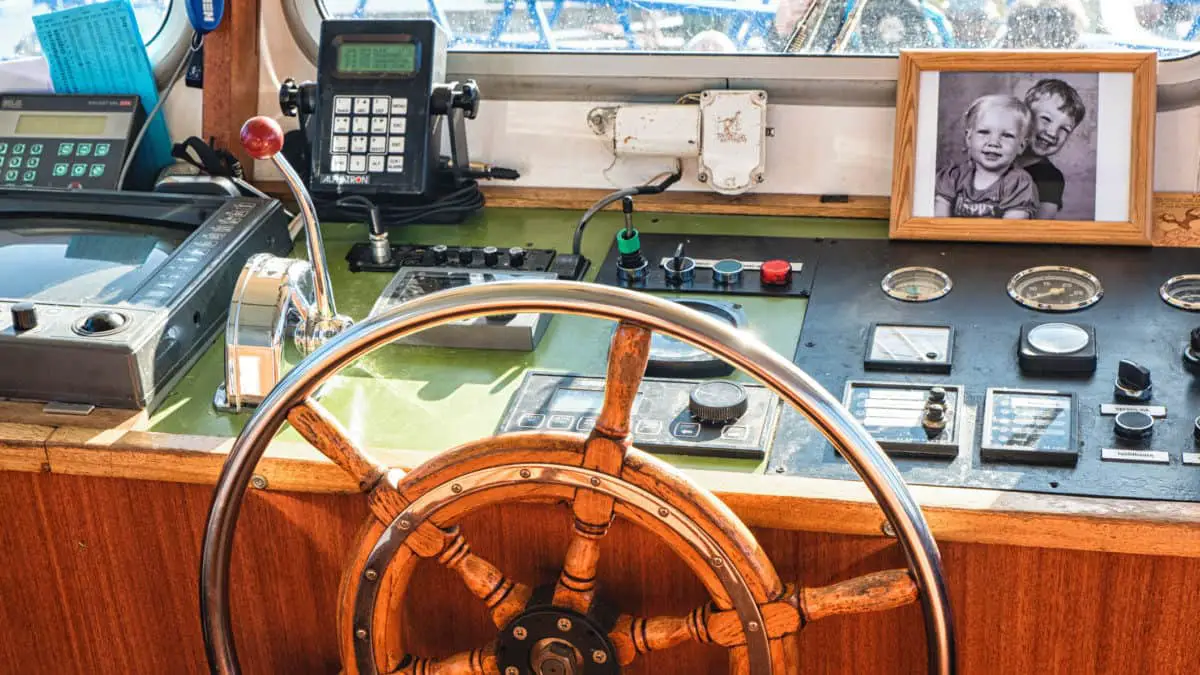
Trawlers Are Easy To Operate
Trawlers contain displacement hulls designed to enable them to navigate smoothly and efficiently through the seawater. The hulls have a rounded bottom while the boat’s bow and stern form a teardrop shape. The hull design affects the boat’s capability, and a ballasted full-displacement hull is best suited for rough waters. But for faster cruising, a trawler with a semi-displacement hull is the better choice.
A user-friendly learning curve makes the trawler an ideal choice for navigating bay areas and large water bodies. And since the boats rely on engine power, you can run them in any weather. Besides, if you are worried about sailing during the night, you need not be since with a trawler, you can sail safely from the inside helm.
Another exciting feature is the trawler’s shallow draft which allows you to fit your boat into marina slips with ease. It also means easy access to remote anchorages.
Trawlers: The Cons
Trawlers have their disadvantages too. Let’s take a look.
Trawlers Are Not That Fast
Unlike catamarans, trawlers do not have incredible speeds. Instead, they sail slowly – but steadily. The boats deliver cruising speeds ranging between 7 and 9 knots (13 to 17km/hr or 13,000 to 17,000m/hr) but can attain maximum speeds of up to 12 knots (22km/hr or 22,000m/hr). As such, you always need to pay attention to the weather forecast since your trawler might not be able to outrun a storm.
Again, a trawler designed with a full-displacement hull offers the stability required to combat rough seas, but at the expense of speed. Therefore, such trawlers cruise rather slowly.
Trawlers Have High Maintenance Costs
Cruising trawlers are like tiny homes, and given their numerous luxurious amenities, it is best to maintain them the same way you’d maintain your home. This means ensuring regular upkeep for the boat’s plumbing and electrical systems as well as the HVAC system.
Keeping a trawler’s tanks full can be a significant expense too due to fluctuating and unpredictable gas prices. Furthermore, extensive and continuous use makes trawlers prone to much higher repair and maintenance fees than other vessels.
Trawlers Heel in Choppy Waters
Unlike catamarans, which do not heel, trawlers tend to roll from one side to the other quite a bit. This happens both while underway and at anchor. This can be pretty uncomfortable, especially when you are trying to get a good night’s rest. It can also make it more challenging to control the boat in rough weather.
Trawler engines can get a little noisy, too, which can make your nights a little uncomfortable as well.
Which One Should You Go For?
Should you go for a catamaran or a trawler? There is no simple way to answer this question as both are excellent sea-faring vessels capable of delivering a satisfactory cruising adventure. Moreover, the right boat choice for you will depend on the intended use as well as your personal preference.
For instance, if you are planning to go on long-distance voyages that include ocean crossings, then the obvious choice would be a catamaran. However, if you have no plans to cross major oceans but still want to give your big family a long cruising vacation – or an overnight trip – then a trawler would be your best bet.
Final Words
Catamarans make ideal yachts for avid sailors and families interested in a relaxing and comfortable cruising vacation. Their greatest appeal comes from the generous spacing, stability, and comfy living quarters of these luxurious yachts.
On the other hand, trawlers are incredibly roomy, stable, and offer you all your usual home comforts, making them well-suited for an extended vacation or trip. Their large fuel capacity and fair cruising speeds also make them ideal for long-distance cruising.
While both boats have their pros and cons, going for either one will most likely depend on your budget, your cruising plans, or your personal preference.
Owner of CatamaranFreedom.com. A minimalist that has lived in a caravan in Sweden, 35ft Monohull in the Bahamas, and right now in his self-built Van. He just started the next adventure, to circumnavigate the world on a Catamaran!
Leave a Reply Cancel reply
Your email address will not be published. Required fields are marked *
Save my name and email in this browser for the next time I comment.
Recent Posts
Must-Have Boat Gear for Catamaran Sailors!
Sailing is probably the most gear-intensive activity I've ever done; there are so many decisions to be made about what gear to buy now, for tomorrow, and what to definitely never buy. The gear on...
6 Best Trailerable Trimarans For Bluewater and Coastal Sailing
Having a boat costs a lot of money, even when you are not using it, marina fees, etc. And once it is in the water most sailors never go very far from their "home marina" and sailing will be somewhat...


Stellar Outdoor Life
Explore, discover, and connect with the outdoors!

Catamaran vs Trawler: Which Boat Is Right for You?
When it comes to choosing the right type of boat, the decision can be overwhelming. Two popular types of boats that often come up in comparison are catamarans and trawlers. Both boats have their own unique features and advantages. In this article, we will explore the differences between catamaran vs trawler, and the factors that should be taken into consideration when choosing between the two.
Overview of Catamarans
Catamarans are multi-hull boats that have two parallel hulls connected by a bridge or deck. These boats are known for their stability and spaciousness. Because of their two-hull design, catamarans tend to have a wider beam (the width of the boat) than monohull boats of similar length. This means that they can have more living space and storage capacity than their monohull counterparts. Additionally, catamarans have a shallow draft, which means that they can access shallow waters that other boats cannot.

Overview of Trawlers
Trawlers , on the other hand, are typically single-hull boats that are designed for long-distance cruising. They are known for their fuel efficiency and sturdy construction, which allows them to handle rough seas. Trawlers are often equipped with a displacement hull, which means that they are designed to move through the water slowly and steadily. This design allows them to travel long distances without burning too much fuel.

Comparison of Catamarans and Trawlers
Here’s a quick comparison table that highlights some of the key features of catamarans and trawlers:
| Stability | High | Low |
| Space | More living space due to wide beam | Less living space due to narrow beam |
| Draft | Shallow, can access shallow waters | Deeper, may have difficulty in shallow waters |
| Fuel Efficiency | Moderate | High |
| Speed | Fast due to lightweight design | Slow due to displacement hull |
| Fishing | Not as ideal as trawlers | Ideal with features like fish lockers, live wells, and rod holders |
| Comfort | High, due to wide beam | High, due to more headroom, storage, and living space |
| Maneuverability | More difficult to maneuver in tight spaces | Easier to maneuver in tight spaces |
| Berthing Options | May have limited berthing options due to wide beam | May have limited berthing options due to draft |
| Price | More expensive | Less expensive |
| Maintenance | Requires more maintenance than trawlers | Requires less maintenance than catamarans |
Keep in mind that these features are generalizations and not absolute. It’s important to consider the specific model and make of the catamaran or trawler, as well as your individual needs and preferences, when making a decision.
When comparing catamarans and trawlers, there are a number of factors that should be taken into consideration. These include:
1. Stability
One of the most significant advantages of catamarans is their stability. Because of their two-hull design, catamarans have a wider base than trawlers, which makes them less prone to tipping over in rough seas. Additionally, the two hulls provide more buoyancy, which means that the boat will float higher in the water. This can make for a smoother ride in choppy conditions.
Catamarans also tend to have more living space than trawlers. Because of their wider beam, catamarans can accommodate more cabins, bathrooms, and common areas than trawlers of similar length. Additionally, the deck space on a catamaran is usually larger than that of a trawler, which makes them a popular choice for those who like to entertain on board.

3. Fuel Efficiency
When it comes to fuel efficiency, trawlers have the edge over catamarans. Trawlers are designed to move through the water slowly and steadily, which means that they burn less fuel than boats that are designed to go faster. Additionally, trawlers are often equipped with diesel engines, which are more fuel-efficient than gasoline engines.
4. Handling
Because of their two-hull design, catamarans can be more difficult to maneuver than trawlers. They have a wider turning radius and can be more difficult to handle in tight spaces. Additionally, catamarans tend to be more sensitive to wind and currents than trawlers, which means that they require more attention when docking or maneuvering in close quarters.
Catamarans are generally more expensive than trawlers of similar size and age. This is partly due to their popularity and the demand for them in the market. Additionally, catamarans require more maintenance than trawlers, which can add to the overall cost of ownership.

Catamaran Pros:
- Stability : The two hulls of a catamaran provide greater stability than a single-hull boat, making it less prone to tipping over in rough seas.
- Space : Catamarans tend to have more living space than trawlers of similar length due to their wider beam. This can make them more comfortable for extended trips or for entertaining guests.
- Shallow Draft : Catamarans have a shallow draft, which allows them to access shallow waters that other boats cannot, making them ideal for exploring coastal areas or shallow bays.
- Speed: Catamarans can be faster than trawlers due to their lightweight and streamlined design. This can make them an ideal choice for those who enjoy sailing or racing.
- Comfort: The wider beam of a catamaran provides more stability and greater comfort than a trawler, particularly in choppy conditions.
Catamaran Cons:
- Handling: Catamarans can be more difficult to maneuver than trawlers due to their wider turning radius and greater sensitivity to wind and currents. They may require more attention when docking or maneuvering in close quarters.
- Price : Catamarans are generally more expensive than trawlers of similar size and age due to their popularity and high demand.
- Maintenance : Catamarans require more maintenance than trawlers, particularly with regards to the two hulls that need to be maintained and repaired.
- Limited Berthing Options : Catamarans may have limited berthing options due to their wide beam, which can make it difficult to find suitable mooring spots in certain marinas or harbors.
- Reduced Comfort in High Winds : In strong winds, catamarans can become uncomfortable due to the greater surface area they present to the wind, leading to more pitching and rolling.
Trawler Pros:
- Fuel Efficiency : Trawlers are designed for slow and steady movement through the water, which means that they burn less fuel than boats that are designed to go faster. Additionally, they are often equipped with diesel engines, which are more fuel-efficient than gasoline engines.
- Sturdy Construction : Trawlers are built to handle rough seas and long-distance cruising, making them a reliable choice for extended trips.
- Long-Range Cruising : Trawlers are designed for long-distance cruising, with a displacement hull that allows them to travel long distances without burning too much fuel.
- Fishing : Trawlers are often equipped with features like fish lockers, live wells, and rod holders, making them an ideal choice for those interested in fishing.
- Comfort: Trawlers are designed for comfort and often have more headroom, storage, and living space than other boats of similar size.
Trawler Cons:
- Speed: Trawlers are designed for slow and steady movement through the water, which means that they may not be suitable for those who enjoy sailing or racing.
- Limited Berthing Options : Trawlers may have limited berthing options due to their draft, which can make it difficult to find suitable mooring spots in shallow waters.
- Less Stability : Trawlers are less stable than catamarans due to their single-hull design, making them more prone to tipping over in rough seas.
- Less Space : Trawlers may have less living space than catamarans of similar length due to their narrower beam.
- Difficulty Maneuvering in Tight Spaces : Trawlers can be difficult to maneuver in tight spaces due to their large turning radius, making them less suitable for navigating in crowded harbors or marinas.

Which is Right for You?
Ultimately, the decision between a catamaran and a trawler comes down to personal preference and intended use. If you are looking for a boat that is spacious and stable, and that can handle shallow waters, a catamaran may be the best choice for you. However, if you are looking for a boat that is fuel-efficient, sturdy, and can handle long-distance cruising, a trawler may be the better option.
It’s also important to consider the type of activities you plan to do on your boat. If you are interested in fishing, a trawler may be the better option, as it is designed for slow and steady movement through the water, which is ideal for trolling. Additionally, trawlers often come equipped with features like fish lockers, live wells, and rod holders.
On the other hand, if you plan to entertain guests or host parties on your boat, a catamaran may be the better option. The wide beam of a catamaran provides plenty of space for socializing, and the shallow draft allows you to anchor in shallower waters closer to shore.
Another factor to consider is your level of boating experience. Catamarans can be more difficult to maneuver than trawlers, particularly in tight spaces. If you are a novice boater, a trawler may be the better option, as it is generally easier to handle and maneuver.
Finally, it’s important to consider your budget when choosing between a catamaran and a trawler. As mentioned earlier, catamarans are generally more expensive than trawlers of similar size and age. Additionally, maintenance costs for a catamaran can be higher due to the need for two hulls to maintain and repair.
The Final Verdict
Choosing between a catamaran and a trawler requires careful consideration of a number of factors, including stability, space, fuel efficiency, handling, and price. Ultimately, the decision comes down to personal preference and intended use, and it’s important to take into account your level of boating experience and your budget . With the right information and careful consideration, you can choose the boat that is perfect for you and your boating needs.

Roy Franklin is a writer and editor for Stellaroutdoorlife.com. He enjoys fishing big lakes, rivers, and streams for trout, largemouth and smallmouth bass, crappie, panfish, and whatever else he can catch on live and artificial bait. Roy shares his expertise with everyone who wants to learn new ways and tactics to catch fish. He loves testing and rating new products and recommending fishing gear people can try.
Share this:
Leave a comment cancel reply.
Save my name, email, and website in this browser for the next time I comment.

- THE PRINCESS PASSPORT
- Email Newsletter
- Yacht Walkthroughs
- Destinations
- Electronics
- Boating Safety

The Power Catamaran Compilation
- By Yachting Staff
- Updated: December 21, 2018
Power Catamarans have been growing leaps and bounds in popularity, and, in lengths and widths. And for good reason. These cruise-centric yachts offer homelike livability for avid travelers, are fuel efficient and are fairly intuitive to run. Power cats are popular in the bareboat charter market too, for these very reasons.
Here, we take a look at 12 catamarans ranging from a cruising-couple-size 36-footer to a 78-footer for friends, family and some more friends. And there are myriad power options: outboards, diesel inboards, hybrid or even all-solar power.
Fountaine Pajot MY44
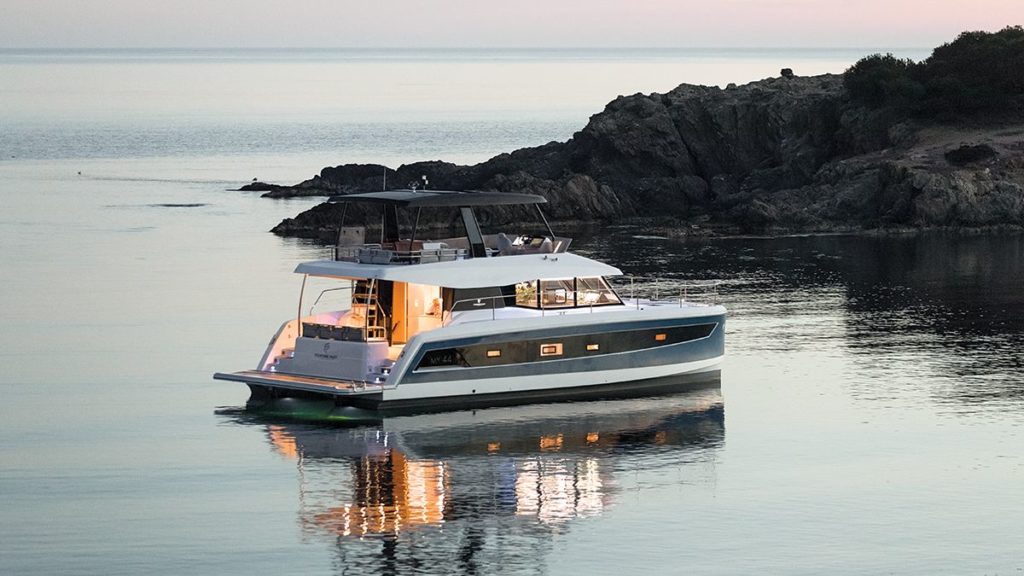
The Fountaine Pajot MY44 , a creation of Italian architect Pierangelo Andreani and French designer Daniel Andrieu, has a main deck that’s open from the aft-deck seating all the way forward to the starboard helm station. The sense of spaciousness is significant, for several reasons. First, four glass panels aft can all slide to port, creating an indoor-outdoor space with the aft deck and salon. In the salon, 32-inch-high windows extend for 12 feet down the sides of the yacht, with three sections per side, bringing in natural light along with the three forward panes that comprise the windshield. Finally, 6-foot-6-inch headroom provides vertical clearance, with a 21-foot-7-inch beam that adds interior roominess while keeping the yacht stable.
Read more: Fountaine Pajot MY44

Silent-Yachts 55
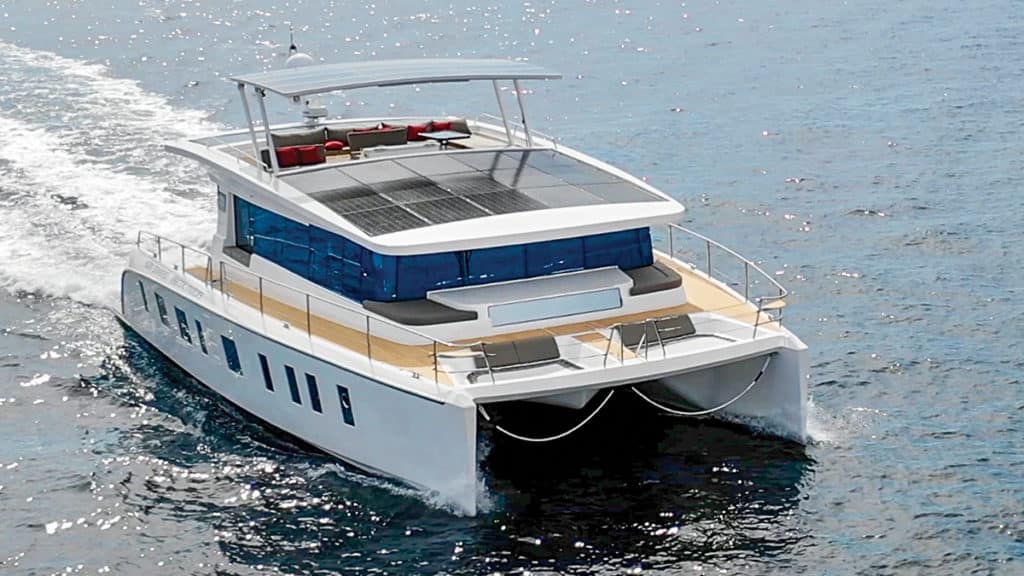
The ideas about which solar panels, electric motors, inverters and the like to use — and more importantly, Michael Köhler says, how to configure them — became the basis for the brand Silent-Yachts. The company offers 55-, 64- and 79-foot catamarans that run on solar-electric propulsion. The Silent 55 premiered this fall, and the 64 is sold out for the next two years, Köhler says.
Read more: Silent 55
Horizon PC74
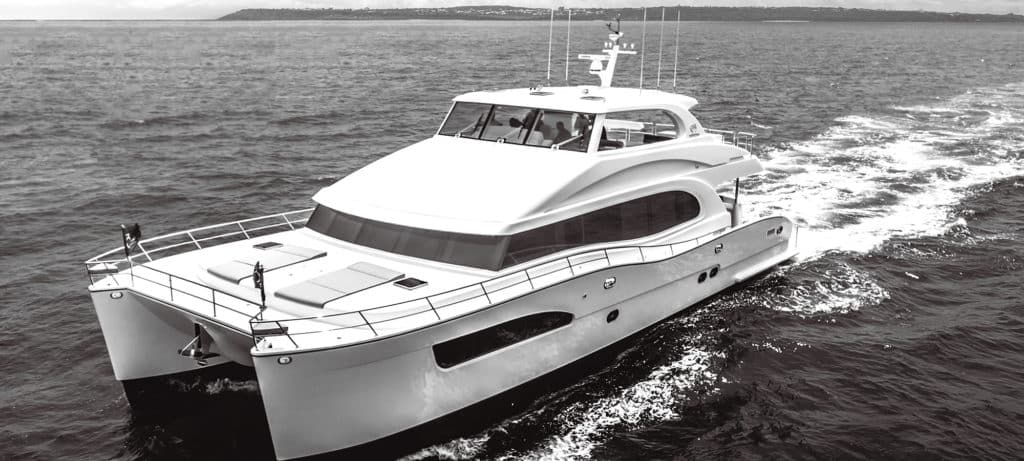
As founder and director of The Powercat Company, a Horizon Power Catamarans distributor, Stuart Hegerstrom had long believed that catamaran builders needed to design their yachts to more stylish standards.
“The boats were very boxy,” he says, based on his years of experience with cats in the charter market. He and his partner, Richard Ford, asked Horizon to produce models that had high-end finishes and looked good inside and out.
The Horizon team brought in mega-yacht designer JC Espinosa to work with its own craftsmen. The result aboard the Horizon PC74 is a catamaran with exterior styling, layout and functionality that should appeal to private and charter owners alike.
Read more: Horizon PC74
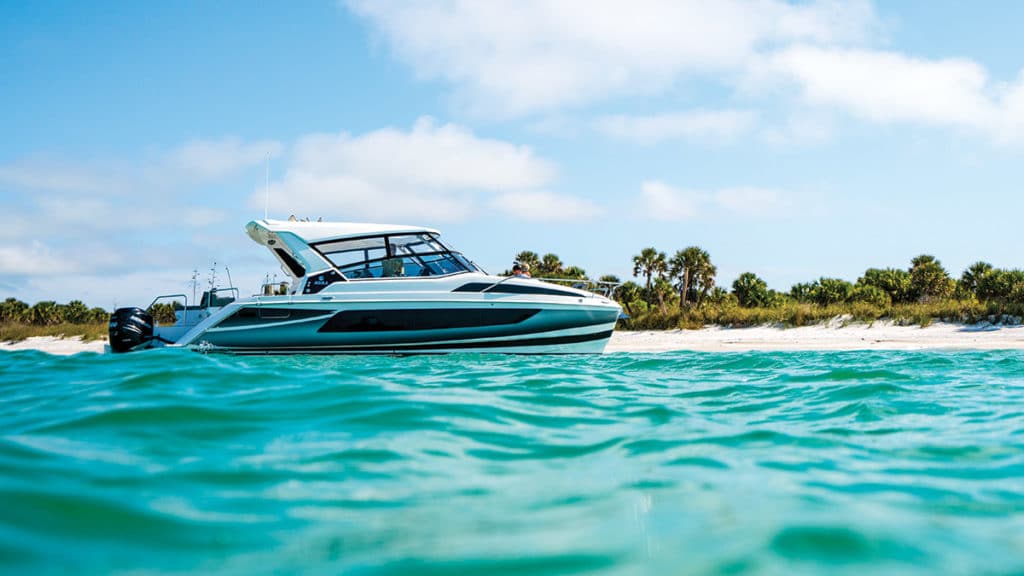
The Aquila 36 is a departure from her sisterships in that she is an outboard-powered, express-cruiser-style catamaran, but she also adheres to MarineMax’s philosophies.
With a single main living level from bow to stern and a beam of 14 feet 7 inches, the Aquila 36 is like a bowrider on steroids. She has seating that can handle 20 adults for outings and barbecues, and there are two staterooms below, one in each hull, for family weekending. The staterooms have nearly queen-size berths, en suite heads, stowage and 6-foot-6-inch headroom.
Read more: Aquila 36
Lagoon Seventy 8 Powercat
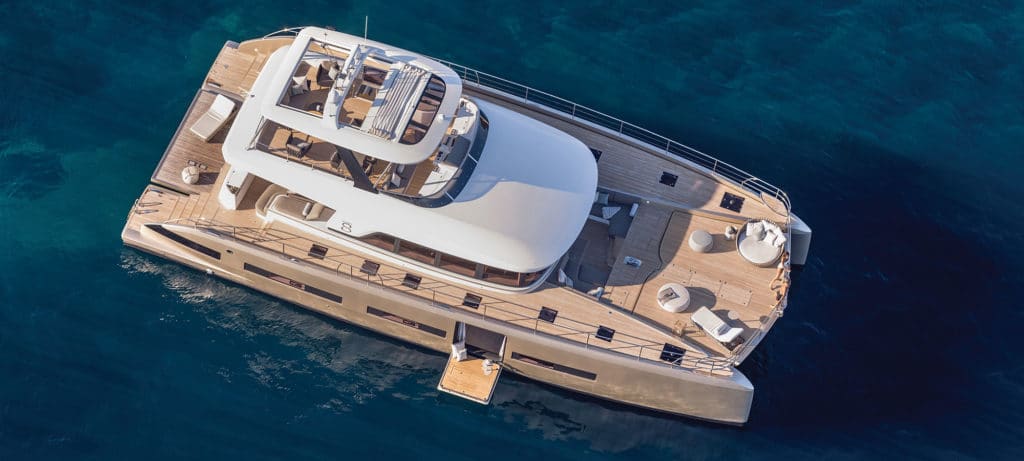
Lagoon is a division of Groupe Beneteau, the world’s largest builder of sailing yachts, and the Lagoon Seventy 8 Powercat is a developmental sistership of its Seventy 7 super sailing cat. The Seventy series yachts are built at Construction Navale Bordeaux in France, which had to add a new yard to construct these catamarans because they require separate stern molds for the power and sail versions.
Read more: Lagoon Seventy 8 Powercat
Horizon PC60
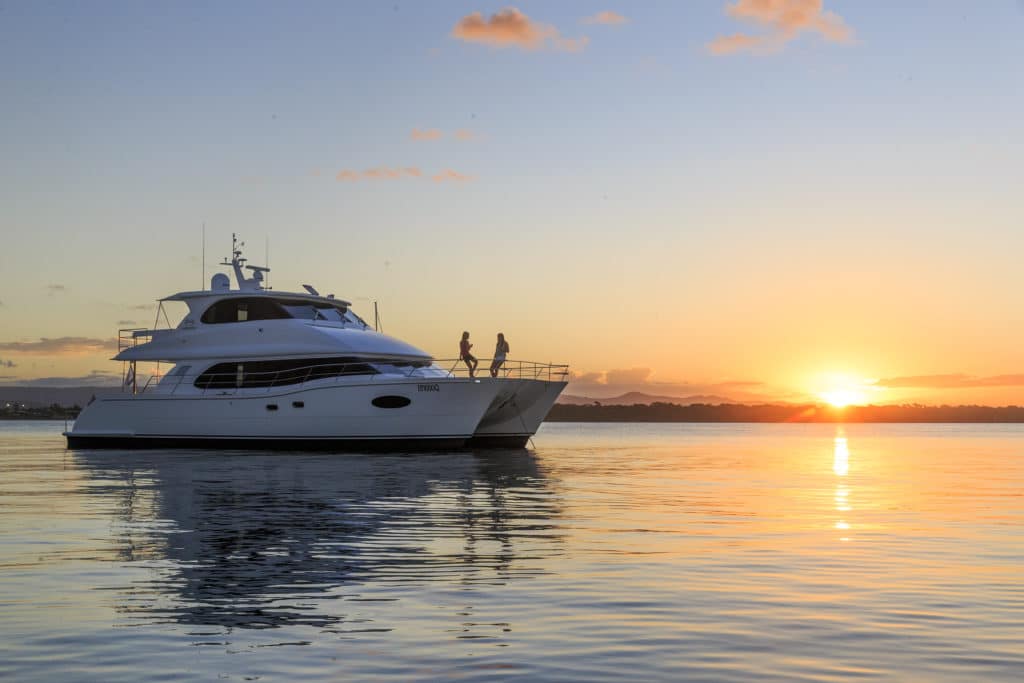
To understand the Horizon PC60 power catamaran , you need to put aside preconceived notions about midsize yacht amenities. For example, main-deck master suites are the province of yachts over 100 feet length overall. Incorrect. This 60-footer has an elegant and spacious owner’s stateroom on the same level as the salon. If you want a 14-foot center console tender on a 60-foot yacht, you have to tow it. Wrong again. On the PC60, you hoist it onto the upper deck, no problem.
Read more: Horizon PC60
40 Open Sunreef Power
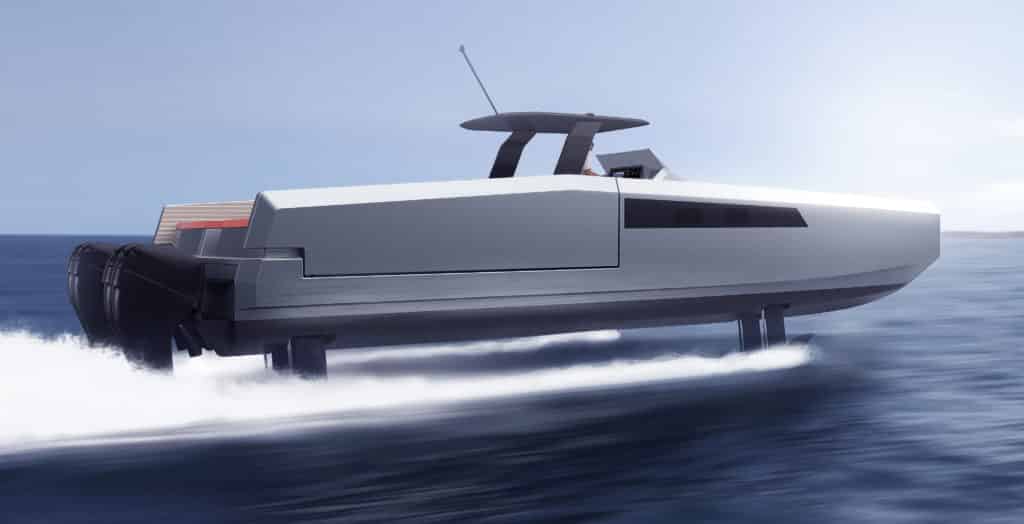
Sunreef is known for pushing the boundaries of catamaran design, incorporating four adjustable hydrofoils into a twin-hulled speedboat.
The Polish builder is one of several European builders (including Evo, Fjord, Wider and Wally) transforming the open day-boat category with creative designs. Beyond its hydrofoils, the 40 Open Sunreef Power ‘s cockpit has side “wings” along the aft gunwales that fold out at anchor, widening the beam from 17 feet to 22 feet 9 inches.
Read more: 40 Open Sunreef Power
Sunreef 50 Amber Limited Edition
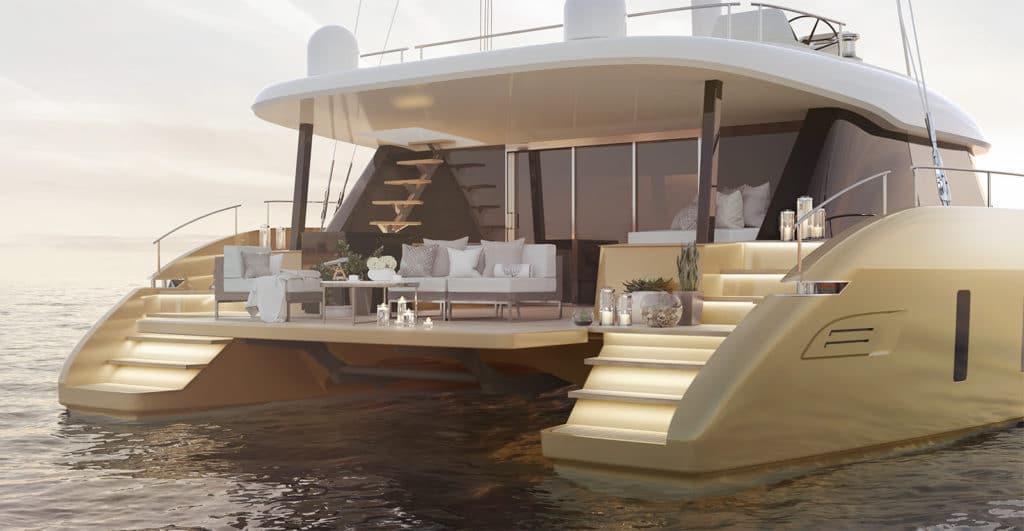
Sunreef Yachts introduced its 50 Amber Limited Edition , with plans to launch just 10 hulls of the exclusive design.
The Sunreef 50 Amber Limited Edition will have a carbon fiber mast and boom, four layout options and numerous amber-colored elements, including the hull.
Read more: Sunreef 50 Amber Limited Edition
Lagoon 630 Motor Yacht
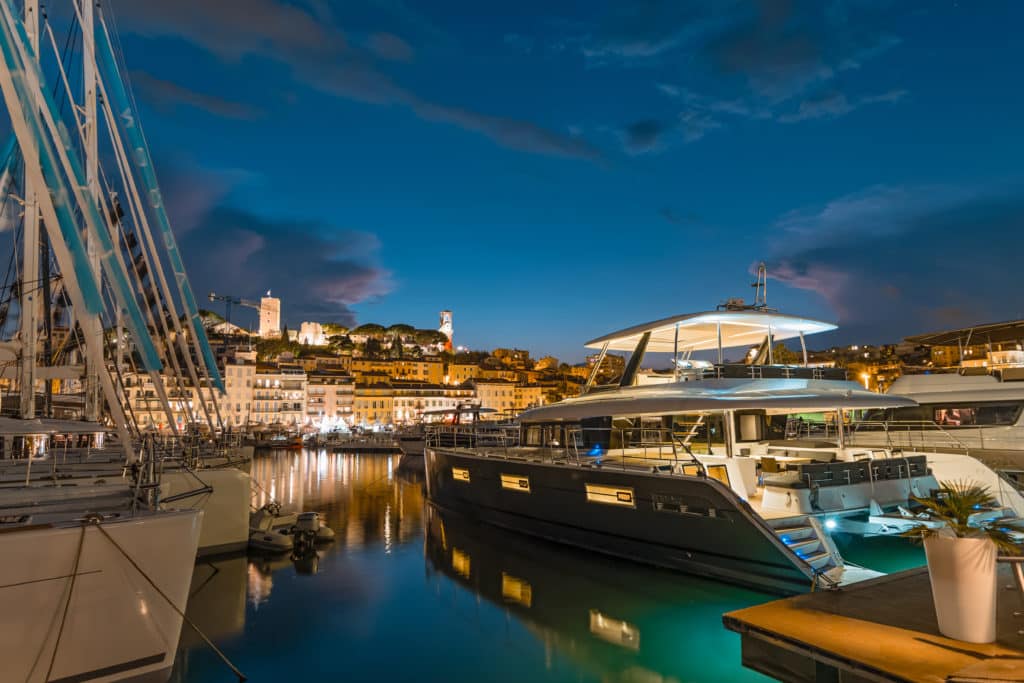
Fitted with the optional twin 300-horsepower Volvo Penta D4 diesels, the Lagoon 630 MY burns only 1.64 gph total at 6 knots, giving a theoretical range of 2,952 nautical miles with standard tankage of 793 gallons. Hull No. 1 had an optional 502-gallon tank, giving it transatlantic range.
Luxury, stability and economy are all hallmarks of Lagoon’s return to luxury motor yachts. If you can take a ride, it will be worth your time.
Read more: Lagoon 630 Motor Yacht
Fountaine Pajot MY 37
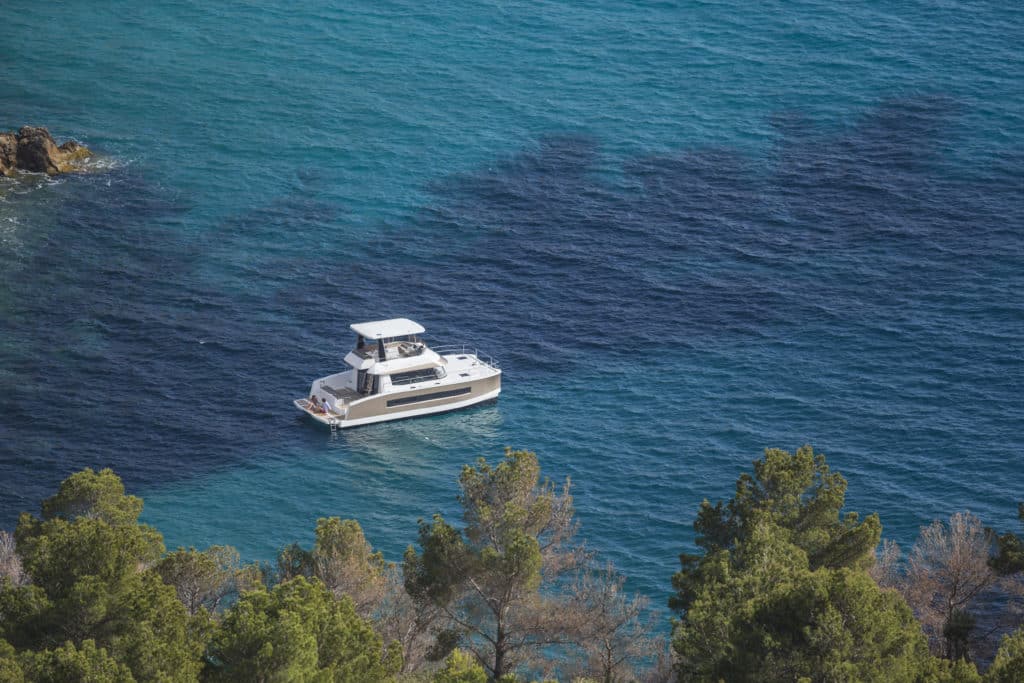
The Fountaine Pajot MY 37 easily accommodates the seafaring family with three- and four-stateroom options. In the three-cabin version, called Maestro, you’ll find an owner’s suite in the portside hull with a queen-size berth and en suite head. Two double-berth cabins and one more head are available for the kids. If your brood is bigger, the Quator setup features four double cabins with two heads.
The 37 is a traveler and can be powered with twin 150 hp or 220 hp Volvo Penta diesels. Top speed with the smaller engines is 17 knots, while it’s 20 knots with the bigger power plants. Interestingly, at 7 knots, the fuel consumption is the same, with either set of motors offering voyagers a 1 ,000-nm range.
Read more: Fountaine Pajot MY 37
Solarwave 64
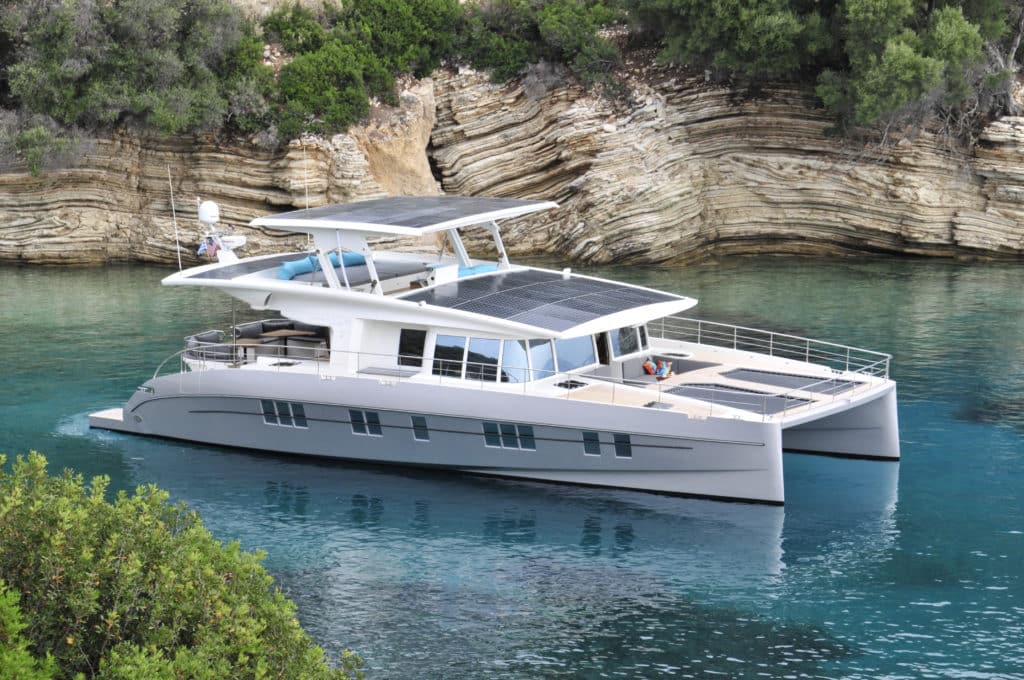
Many yachts boast eco chops because they have a handful of solar panels that power the microwave or navigation lights. The Solarwave 64 , launched last summer, has the potential to run on sunshine alone. The vessel’s 42 solar panels generate 15 kW that are stored in batteries weighing about 1,300 pounds. They connect to electric motors.
Read more: Solarwave 64
Glider SS18
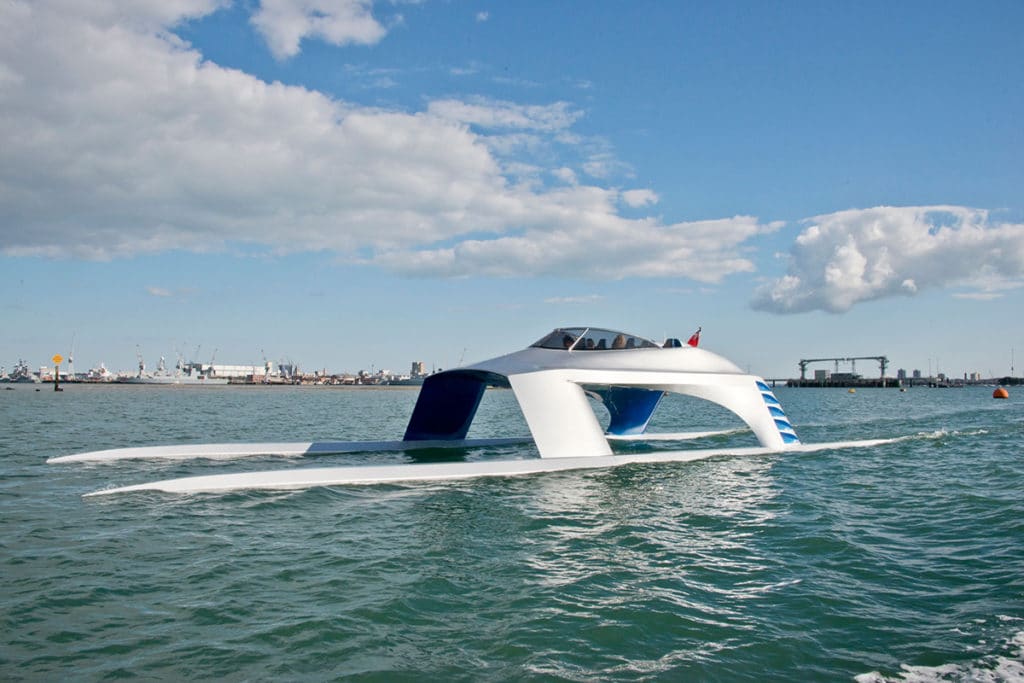
This British builder says it strives for design innovation and the Glider SS18 displays that DNA, the result of 8 years of research and development. She has a head-turning, catamaran hull form constructed from aluminum and composite materials. She is 60 feet LOA with a 17-foot beam, and has a relatively shallow 1-foot draft. Powered by quad Yamaha 300 hp outboards, she can reportedly reach 50 knots, and with her Stability Control System (SCS), should give a smooth ride while doing it.
Read more: Glider SS18
- More: aquila , Aquila Boats , Express and Flybridge Cruisers , Fountain Pajot , Glider Yachts , Horizon Power Catamarans , Lagoon , Power Catamarans , Silent-Yachts , Sunreef , Yachts
- More Yachts

Bering Yachts Showcases Exploration

Merritt 88 Skybridge Reviewed

Tankoa Launches “Diamond Binta”

Duffie Boatworks 70 Reviewed

For Sale: Pershing 82 VHP

Sunseeker Predator 55 Prepares for Debut

- Digital Edition
- Customer Service
- Privacy Policy
- Email Newsletters
- Cruising World
- Sailing World
- Salt Water Sportsman
- Sport Fishing
- Wakeboarding
- Find Us On Facebook
- Find Us On Instagram
- Watch Us On YouTube
- Find Us On LinkedIn

Power Catamarans vs Sail Catamarans, What’s the Right Choice For You?
Sail and power catamarans are both great boats with distinct advantages. To choose what is best for you, think about how you will be using the boat. The good news is they both work with the Business Yacht Ownership approach.
Sail Catamarans

- Sailboats are better if you want to follow the sun or do longer range cruising.
- With the right prop and engine, sailboats can do 9-10 knots and are very sea-worthy. They provide comfort at sea. If you just feel like laying back and relaxing, you can almost forget the mast is there. But, when the conditions are ideal, you will be able to sail. New designs and technological advancements make sail handling easier than ever.
- Sailboats are quiet and promote socialization. Generally, they can handle more guests at a time, whether they are socializing or sleeping.
- Sailboats cost less per cubic ft. of volume. The Helia 44 has as much or more room/volume than the Cumberland 47.
Power Catamarans

- They have low clearance. If your cruising plans involve a bridge with height restrictions, a power boat may be the better option.
- A properly, dedicated purpose catamaran powerboat gives significantly better speed and range than a comparable monohull powerboat.
- The Fountaine Pajot Motor Yacht offers the exceptional characterics of the catamaran platform, giving you a very comfortable ride and virtually eliminating rolling at anchor.
- The Fountaine Pajot Power cat is less expensive to run than a monohull and can compete with the economy of a trawler. The power cat also offers the efficiency of the hull, which allows you to go faster when you need to (up to 22 knots or so). This is not possible under normal conditions with a trawler or sailing cat.
Learn more about power catamarans
Senior Sales Consultant, Partner [email protected] 410-703-5655 More from Eric >> Boat Business Webinars, Videos, Blogs, Learning center and more.
Disclaimer : The information, views , opinions , and conclusions expressed in any article , blog, video, or other form of media posted or linked herein are those of the authors and do not necessarily reflect the views of Atlantic Cruising Yachts, LLC. Nothing contained herein has been approved or otherwise endorsed by Atlantic Cruising Yachts, LLC and such company shall have no liability for any content.
ESE, LLC is totally responsible for the content of this article. We are not tax advisers. You should obtain tax advice from a professional tax adviser for any matters relating to setting up a business, or tax implications .
Notice of Use of Cookies
We use cookies and similar technologies to recognize your repeat visits and preferences, as well as to measure the effectiveness of campaigns and analyze traffic. To learn more about cookies view our Privacy Policy . By continuing to use our site, you consent to the use of cookies.
- The Tula Shop
- Tula’s Crew 🏴☠️
- Boat Finances
- Tips and Tricks
- Experiences and Opinions
- Traveling with a Dog
- Marina Reviews
- The Captain and Crew
- Mountain Myst Is For Sale
- Recommended Gear
Trawler vs. Catamaran

We have traveled thousands of miles on both a trawler and a catamaran. The time spent on both boats was thoroughly enjoyed. This article is here to explain to you the pros and cons of a trawler vs. a catamaran.
Trawler vs. Catamaran?
Neverland → adrenaline, the positives of our trawler:.

Look at that view!
Living area. Neverland had a very big open galley with plenty of head room. She also had lots of counter space which made preparing meals super easy.
Helm. There was a helm station both inside and out on Neverland. Our favorite spot to steer was up on the fly bridge. If the weather was nasty we always had the option to steer inside out of the elements.
Weight. She was built to chug along loaded down. Weight was never an issue for us on Neverland. We carried much more than we would ever need and also towed a very large (16ft. Boston Whaler) dinghy.
Draft. Neverland only drew 3’6″ which made it super easy to get close up in the best anchorages.
Slips. At only 34 feet long and 12 feet wide we never had a problem fitting into boat slips.
The Negatives of our Trawler

Where to next?
Speed. They say slow and steady wins the race. That is not the case when trying to out run a storm. At a MAX speed of 7 knots, we always had to keep a very sharp eye on the weather forecast.
Comfort underway. When it was calm we were super comfortable. Choppy seas, however, would not be smooth sailing. Neverland liked to roll side to side in anything more than a foot of chop.
Reliability. Having one engine while traveling in remote places was always a little nerve-wracking. Our fingers were always crossed hoping for a safe Gulf Stream Crossing.
Docking. Have you ever tried docking a big boat with one engine with the wind and current not in your favor? It takes mad skills.
Fuel. Diesel prices can fluctuate but at the end of the day we were still paying for every mile we traveled.
The Positives of our Sailing Catamaran

Home Sweet Home.
Wind-powered. The majority of our miles are completely FREE. The wind fills the sails and we are on our way. Check out how little we spent sailing the Bahamas for 60 days!
Stability. Having two hulls makes us extremely stable in unfavorable conditions. There is very little roll and the motion is very tolerable even in rough waters.
Speed. Adrenaline’s max speed is 13.8 knots! That is almost double what Neverland could go (for FREE)!
Engines. If we get a lull in the wind we also now have TWO diesel engines. This is also a nice piece of mind in case one engine goes we always have a backup.
Docking. Going from a single diesel to twins makes docking a breeze!
Outside space. Have you ever laid on the trampoline of a catamaran while sailing? If not I suggest you put it on your bucket list. This is a great place to hang and relax or chill out with friends.
Separate Cabins. Unlike most catamarans, Adrenaline’ s hulls are not open to the main cabin. We like this set up because when we have guests over everyone has their own separate space. This is also a big help because Jetty is not too fond of “others”.
Negatives of our Sailing Catamaran.

Are there really any negatives??
Low head room. Luckily we are both short. Adrenaline was designed for racing so everything is sleek, simple, and very short. This does not bother us but some of our friends would have a hard time cooking or sleeping comfortably.
Bigger is not always better. Between two engines, multiple sails, rigging, and seven more feet of boat to handle something is always needing maintenance. Then again what do you expect? It’s a Boat.
Weight sensitive. In order to keep her fast, we need to keep her light. That means limiting everything! Which is not necessarily a bad thing. It helps us keep life simple:)
Outside Helm. Our helm station is very exposed to the elements. We recently made a hard bimini for shade but we still get pelted by rain drops when we find ourselves in a storm.
Slips. Having a 20-foot wide berth makes finding a suitable boat slip difficult. Some docks simply cannot accommodate us.
Rudder. We only draw 3’8″ with our dagger boards up, which is not much more than the trawler. Unfortunately, our rudders are the deepest part of the boat. This means we have to be extremely careful in shallow water, if we lose a rudder we lose our ability to steer. It is also a big pain in the but with areas populated by crab traps. If we accidentally run one over they get stuck around the rudder and are a big pain to get off.
Everything has its own set of pros and cons but I can safely say that we are now forever catamaran people. Our trawler was an awesome boat and we do not regret having her for a second but the speed and stability of a catamaran is like nothing else!
Thanks for reading:)

You may also like...
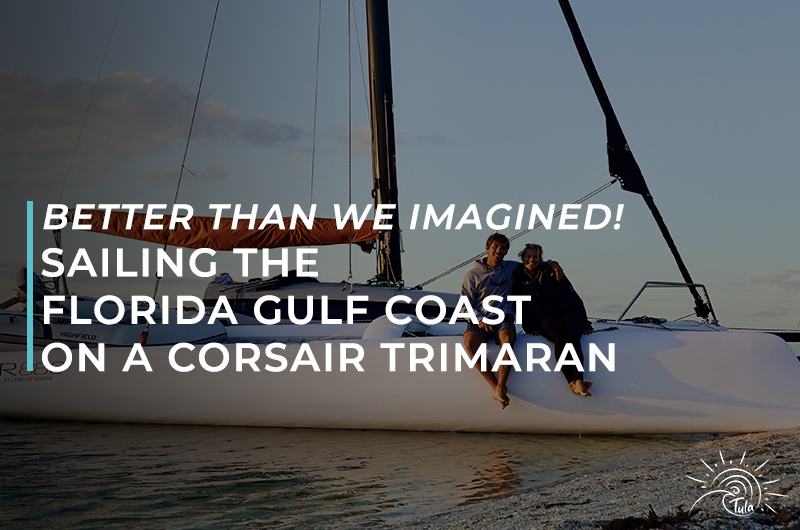
Cheeseburger in Paradise: Sailing the Florida Gulf Coast
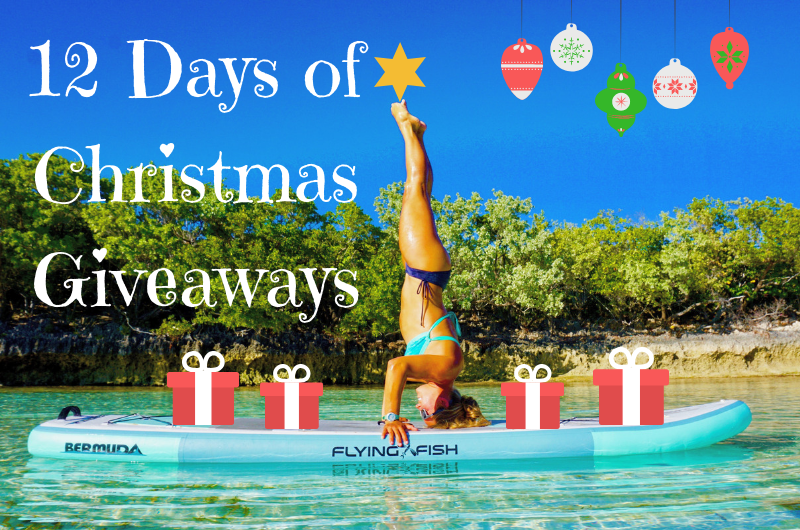
12 Days of Christmas GIVEAWAYS with Tula’s Endless Summer
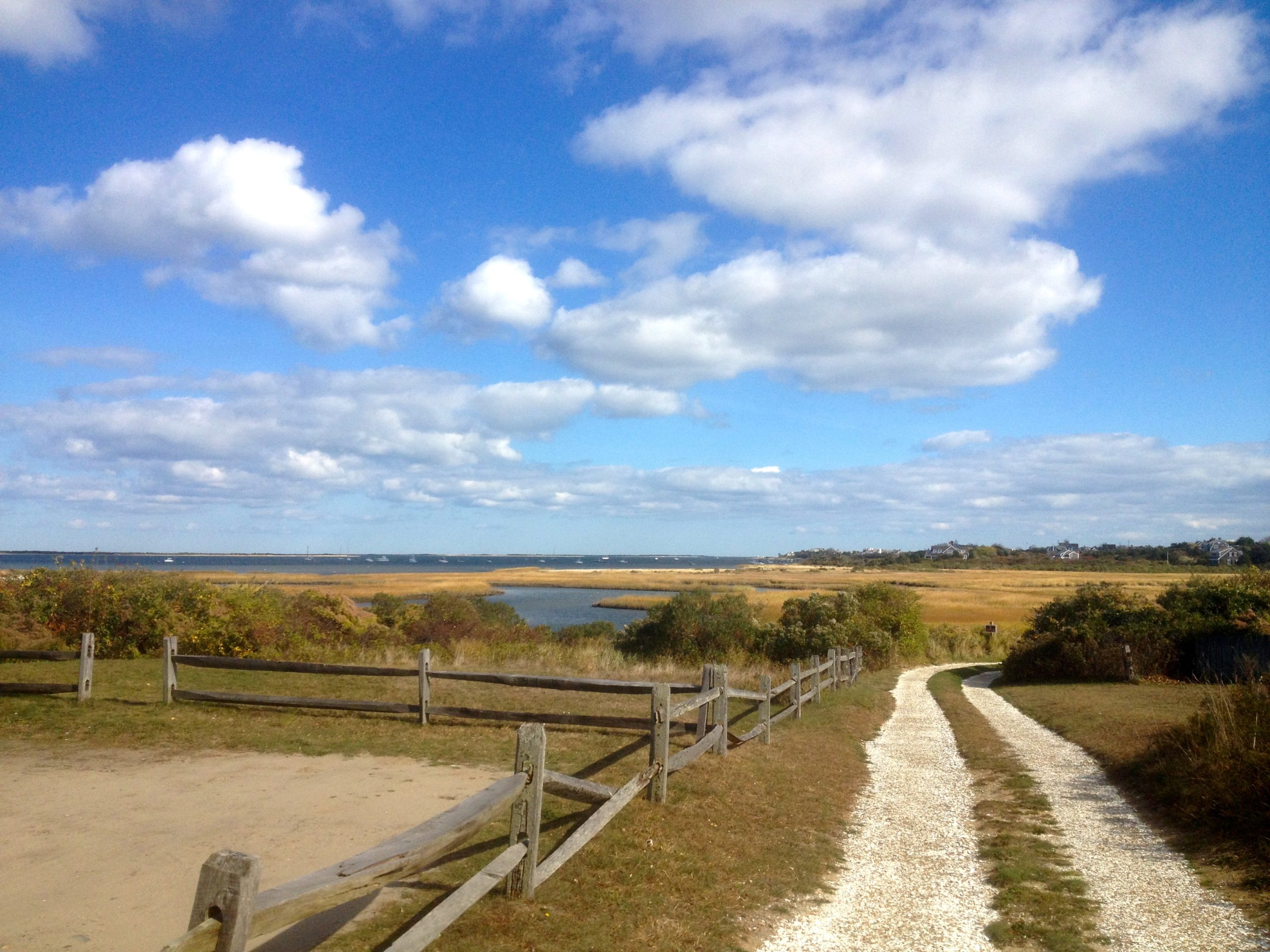
7 Small Seaside Towns That You Need To Visit – And What To Do There
5 comments on “ trawler vs. catamaran ”.
Thank you for the great article. Adrenaline clearly takes the contest for highest possible speed, but I am curious about what average speed you use to plan legs . . . Or maybe you’re wiser than me and simply don’t worry about it.
Hi Tula crew. Thanks for the detailed comparison. I’ve lived in Florida for forty years but only been on a cat once. I spent several hours just laying on the trampoline. It’s like riding a magic carpet. I hope you all have a great summer and look forward to following the next great adventure.
Nice work on this comparison Sierra. Navigating in the shallows seems stressful. Do sailing vessels ever carry a spare rudder? Let’s say I have a motor boat, was wondering who can give a tow back to port in the Bahamas? I doubt SeaTow operates there – what do you do if you break down in a remote place?
Everthing is a compromise, Im trying to decide on trawler or cat. The article was great, I wonder what your dog likes best? Cats have a higher coolness factor, we all want to have some of that lol. And there is the power cat that goes 20 knots. The nice thing is most of these are for rent so you can go and rent a cat or trawler if you have the cash. I hope a thousand people show up at the boat show to meet you guys. You have quite a following. Take care and thanks for all the info.
I wished you also compared catamarans vs trawlers with sails like e.g. Nordhavn 56 MS, Diesel Duck, Shannon 53 HPS, as there are many who say that motorsailers have the best of both worlds.
Leave a Reply Cancel reply
Your email address will not be published. Required fields are marked *
Save my name, email, and website in this browser for the next time I comment.
Sign me up for the newsletter!
Notify me of follow-up comments by email.
Notify me of new posts by email.
Popular posts
- Florida Anchoring Laws
- DIY TRUCK CAMPER REMODEL
- Bringing a Dog to the Bahamas- What is required? UPDATED December 2023

- Forum Listing
- Marketplace
- Advanced Search
- All Topics Sailing
- Cruising Under Sail
- SailNet is a forum community dedicated to Sailing enthusiasts. Come join the discussion about sailing, modifications, classifieds, troubleshooting, repairs, reviews, maintenance, and more!
Sail Cat vs. Power/Trawler Cat
- Add to quote
I’m looking for anyone with first hand experience on both type of boats here. I’ve sailed on Catamarans over the years and I do appreciate sailing and it’s many benefits. However, I’ve recently started looking at several Power Cats that are very efficient at slow cruise (7 to 10 kts). I figure there is some wash in expenses from loosing the cost of maintaining sail and rigging? However, my main question is about my concern of the potential loss of the stabilizing of the ride/boat that comes with sails while underway. My plan is to cruise from the east coast to Grenada and basically run Grenada to .... maybe the Bahamas (maybe just stay south of PR?) for several years or longer depending, when I retire. I read so many times about everyone doing a lot of motoring heading down that I started considering the power cat thing. I’m one of those people who likes power boats and sail boats, lol. I’m power boater in Beaufort, NC in my regular life so to speak but for example, I’ll be sailing a 45 Lagoon in the BVI in July. I’ve just never been on a power cat, except a ferry, to be able to compare. Thanks in advance for any feedback.
Lots of folks with experience on both power and sail boats. Sort of a narrow field, if they both need to be multi-hulls. I think how much one chooses to sail in the Caribbean is a matter of time and patience. It’s not a certainty that you’ll motor often, unless you choose to. If you’re retired, you can always choose a better sailing window. I think this is just going to come down to personal preference for mode of travel. Personally, beyond preferring to sail, I do like the redundancy of propulsion. I suppose most power cats have two motors. I guess one other thought is the aggravation/limitation associated with needing fuel. Especially in the islands, where supplies can be highly variable in cost and quality.
Since most of the roomarans are rather poor sailboats and often need at least one engine running most of the time, I can see no problem with your idea of purchasing a power cat instead. Very few of the bareboat cats we see down here actually sail between anchorages. As most crossings in the eastern Caribbean are 80 miles or less (a day trip for a power cat) the comfort of the trip should not be much of a consideration. The only long trip (offshore) you might have would be from the T&C to the Virgins or PR. If you found the ride too uncomfortable, you could add a small steadying sail like some of the smaller trawlers have. However, you should consider that fuel prices can be many times more than they are in the US, in some places. Also, finding capable and reliable engine repair personnel can be quite difficult, even in the US these days, never mind a small island in the EC. Given that you have the finances to fill your tanks at any price, you are a capable engineer with adequate spares, and you have no desire to cross oceans, I think a power car would be a great way to cruise the Bahamas and eastern Caribbean.
Thanks for your reply Capta. You brought up some good points to consider. I will say that if I do end up going with a sail boat, it will be a Cat. Either way, you still have 2 engines to maintain. However, you can't beat the fact that you can sail if the engines both fail, unlikely as a double failure is. My list of acceptable power Cats is very short as I can't justify it unless they can cruise at sail boat speed...7 to 10 kts, at around 2 to 2.5 gph. I'm not going to be in the super wealthy category. I don't agree that Cats are poor sailing craft. They don't point upwind as well without dagger boards and you could argue under very rough conditions they may be at a disadvantage, but other than that and the price, you can't beat them for living on board. They are faster and more comfortable to ride on under sail too in most conditions. Most of the time you are at mooring or dock and then the extra space pays off. Like you said, retired with weather windows, you can pick your days. JMO.
Thanks for your response. Being able to sail if fuel is unavailable is certainly a plus for sail boat option.
I would imagine fewer complexities with power cat
On the surface you'd think that, but the power cats come loaded with gear that would never be put on a sail cat. Dishwashers, dryers, multiple freezers, reefers, and ice machines, chilled water AC, large generators, massive electronics, etc. And the engines are computer controlled common-rail. Otherwise, all things being equal, I'd agree. Mark
Good synopsis Those folks are banging out a $vacay$..quite a different thing
We have a couple of friends who have moved from sail cat to power cat. Mostly because they settled in a particular area and still wanted to cruise locally. The power cat makes a lot of sense for their usage. The downside, unless you get a really big or specially purposed power cat, is fuel range. If you are looking at a power cat that cruises at 7-10kts at 2-3gph, you are likely looking at small tankage (and a small boat). As Capta pointed out, this isn't a deal breaker for what you are looking to do - BUT, there will be a couple of stretches in there that will need particular planning. Either carrying extra fuel, waiting for a good weather window, or planning fuel stops that aren't convenient, or maybe out of the way. Frankly, I see a lot of potential in power cats - particularly for your described plans. I don't understand your preference for power cat speeds equaling cruising cat speeds, because I see the advantage of power cats to be the ability to make distance quickly on short weather windows. As for cost, I bet the cost of fuel used over 10yrs will be the same as a new set of sails and new standing and running rigging that will be necessary over that time. Maybe less - we are currently re-rigging and getting new sails, and I think the money we are spending could buy enough fuel to take us around the world. One thing to consider is that waterline on a power cat means so much more in comfort underway than it does to a sail cat. It is the opposite at anchor/dock, where a small power cat has the livable space of a larger sail cat. So if you are thinking of a 36' power cat, it will be pretty uncomfortable underway in anything more than mild to moderate conditions, while a 36' sail cat will handle this better. For your intended usage and area, a 44' power cat is probably a minimum. Mark
colemj said: We have a couple of friends who have moved from sail cat to power cat. Mostly because they settled in a particular area and still wanted to cruise locally. The power cat makes a lot of sense for their usage. The downside, unless you get a really big or specially purposed power cat, is fuel range. If you are looking at a power cat that cruises at 7-10kts at 2-3gph, you are likely looking at small tankage (and a small boat). As Capta pointed out, this isn't a deal breaker for what you are looking to do - BUT, there will be a couple of stretches in there that will need particular planning. Either carrying extra fuel, waiting for a good weather window, or planning fuel stops that aren't convenient, or maybe out of the way. Frankly, I see a lot of potential in power cats - particularly for your described plans. I don't understand your preference for power cat speeds equaling cruising cat speeds, because I see the advantage of power cats to be the ability to make distance quickly on short weather windows. As for cost, I bet the cost of fuel used over 10yrs will be the same as a new set of sails and new standing and running rigging that will be necessary over that time. Maybe less - we are currently re-rigging and getting new sails, and I think the money we are spending could buy enough fuel to take us around the world. One thing to consider is that waterline on a power cat means so much more in comfort underway than it does to a sail cat. It is the opposite at anchor/dock, where a small power cat has the livable space of a larger sail cat. So if you are thinking of a 36' power cat, it will be pretty uncomfortable underway in anything more than mild to moderate conditions, while a 36' sail cat will handle this better. For your intended usage and area, a 44' power cat is probably a minimum. Mark Click to expand...
It makes sense to me seeing an emerging build of new cruising cat designs cutting into the trawler market. Not meant to cross oceans
This is a copy of the performance data from a test done by Passagemaker Mag. Pretty impressive numbers. I think fuel tanks are 370 gal. https://www.passagemaker.com/.image...gwNDI5/screen-shot-2013-10-16-at-35246-pm.png
- ?
- 175.5K members
Top Contributors this Month

- Search forums
Follow along with the video below to see how to install our site as a web app on your home screen.
Note: This feature may not be available in some browsers.
- Trawler Forum
- General Discussion
Power Cats vs Trawlers for Passage Making
- Thread starter Open-d
- Start date Feb 16, 2020
- Feb 25, 2020
Biggest hassle is wave action can capsize a Cat. All it takes is ONE big wave.
As the owner of a 47' Power Cat I totally agree with Hollywood!
FF said: Biggest hassle is wave action can capsize a Cat. All it takes is ONE big wave. Click to expand...
Storm survivability should be considered at the design stage for any vessel making offshore passages. Loss of power (clogged cooling or fuel filters, restricted air supply, water ingress, etc) often occurs at the most inopportune time (during a storm), and this can put the solely powered vessel at peril in short order. A vessel with a modest sailing rig could save your life, and that of vessel itself. Add a proper sea anchor installation, and I would challenge a hurricane. The catamaran planform was rated 'best in survivability' in huge breaking wave tests* carried out by Lock Crowther at the prestigious Univ of Southampton. **Note: reference source, Lock Crowther Designs "This work (tank testing at Southampton Univ) has indicated that the well designed catamaran is remarkably safe in breaking waves up to considerable height, even when beam on, we were unable to capsize a power catamaran yacht in the largest wave which could be generated. This corresponded to a 52' wave for a catamaran of 40' beam. Scaling this down to a typical 24' beam cruising cat means she should be O.K. in a 31' breaking beam sea. An equivalent size mono-hull power boat was easily capsized by a 25' breaking sea, and in tests with conventional yachts after the Fastnet disaster, it was found that a 40' mono-hull yacht could capsized in a 12' breaking sea" Click to expand...
TF Site Team/Forum Founder
Reba said: The 2 major questions you need to answer for hull choice is speed and fuel cost. We had a Knight and Carver, Mono 67ft flybridge cruiser naiad fin stabilized and now own a malcom tennant 60ft cat both had around 450hp a side power. The mono with older engines traveled at 10kts for about 18us gallons a side and 7kts @ 12 a side. The cat travels at 18kts@ 18us a side and 9kts @ 4us a side. The cats top speed is 25 the mono was 14. The mono was fin stabilized with naiad and was far more comfortable in large seas at 8-10 kts than the cat is at any speed. For coastal and Caribbean cruising well built ocean designed power cats are great but for ocean crossing a mono is more comfortable on big swells with waves on top and to us in the middle of the night cruising in nasty conditions the mono just felt a lot better. We are currently building a new 65ft cat because of fuel and speed and expect to cruise @19kts using 17 us gallons a side and 27kts at 45 gallons a side ( sea trial top speed). We will only carry 2500 gallons so I do not plan on seeing 20+ after the sea trial and our normal fuel load will be 1500 gallons. Click to expand...
Baker said: SO your K&C 67ft monohull cruised at 7kts at 24 gallons TOTAL???...and 10kts at 36gph TOTAL???....that sounds a little bit off??? Click to expand...
- Feb 26, 2020
Cats do better at higher speeds where their lower wave making is used. At crawler speeds the added hull wetted surface area is a drag penalty . It takes about a 6-1 L/B ratio on each hull to actually get lower wave making.
motoryacht lover
Veteran member.
Didn’t Ted Hood come out with a passagemaking Cat in the 60’ range?
rslifkin said: I was thinking that too. Even 12 gph total sounds high for 7 kts in a boat that long. Click to expand...
motoryacht lover said: Didn’t Ted Hood come out with a passagemaking Cat in the 60’ range? Click to expand...
healhustler
Baker said: Yes he did and it was a bad MFer. I need to try and find it!! Edit...here you go: Used portsmouth marine power catamaran for sale - Twin Robin Click to expand...
healhustler said: I usually say that even if I had the money, I wouldn’t buy it. That boat may be an exception. Click to expand...
- Mar 1, 2020
Cat vs monos [Hi there we are in OZ We have 50 Brady sailing Cat built as an passage maker. Shes built with 100% Ali wieghs ib at 20+ tones. We hsve her on the market at present in Yacthub under Brady passage maker u can get all the info for her there. Been through big storms & hughe seas never flet worried. Shes built to lloyds small ships specs QUOTE=Open-d;847667]How would you compare the blue water capabilities and suitability of a trawler vs a power cat of similar living space?[/QUOTE]
Cats VS MONO There Cats out there bulit for Passage msking, Blue & Green seas.theres pne on yacthub for sale now look it up its a Brady 50 Passage maker.
- Mar 2, 2020
You may want to wait a few hours before the 3rd spam post.
There was a Sunreef 50 at the Miami Boat show that came to the show from Poland on it's on bottom, taking the Northern Atlantic Route. Lech Walesa was at the boat as he's a friend of the owner of Sunreef, Francis Lapp. It's one of their smaller boats and made this winter crossing. All they say about the crossing is that it was as comfortable as one could hope for in a small boat.
Woodland Hills
The fellow I bought my 63’ Hatteras from downsized into an Endevour 45 with twin outboards. Life changes have forced him to put her on the market and she will be at an upcoming Trawlerfest for viewing. Google: power cat Cygnet for details.
Woodland Hills said: The fellow I bought my 63’ Hatteras from downsized into an Endevour 45 with twin outboards. Life changes have forced him to put her on the market and she will be at an upcoming Trawlerfest for viewing. Google: power cat Cygnet for details. Click to expand...
I think that a high thrust version of the 150hp and bigger Yamahas with a giant slow turning prop would be a game changer. Sure people get freaked by having gasoline on board, but that’s based upon inboard engine experience, not outboards.
- Mar 5, 2020
Senior Member
Woodland Hills said: I think that a high thrust version of the 150hp and bigger Yamahas with a giant slow turning prop would be a game changer. Sure people get freaked by having gasoline on board, but that’s based upon inboard engine experience, not outboards. Click to expand...
"How efficient are the modern outboards compared to diesels? And how long do they last?" Many of the new outboards have an almost diesel like service life, IF maintained. "efficient" ? diesel costs more but is heavier , so cents per mile might be a better yardstick than GPH. The easy access and ease of replacement does have a value , but how to value it?
Similar threads
- Jul 5, 2024
- Jun 25, 2024
- Jun 13, 2024
- Mar 31, 2024
- Jul 10, 2024
- Welcome Mat
Latest posts
- Latest: SeaDogAK
- 48 minutes ago
- Latest: dhays
- Today at 2:21 AM
- Latest: d w saville
- Today at 1:38 AM
- Latest: psneeld
- Yesterday at 11:41 PM
- Yesterday at 11:14 PM
- Latest: Comodave
- Yesterday at 10:51 PM
- Latest: paulga
- Yesterday at 10:38 PM
- Latest: meticulousLBI
- Yesterday at 10:32 PM
- Latest: a_braley
- Yesterday at 9:17 PM
- Latest: maardsma
- Yesterday at 9:14 PM
Visit our Popular Forums
- Monohull Sailboats
- Multihull Sailboats
- Powered Boats
- General Sailing
- Antares Yachts
- Fountaine Pajot
- Lagoon Catamarans
Cruising Business
- Boat Classifieds
- General Classifieds
- Crew Positions
- Commercial Posts
- Vendor Spotlight
Life Aboard a Boat
- Provisioning: Food & Drink
- Families, Kids, & Pets Afloat
- Recreation, Entertainment, & Fun
- Boat Ownership & Making a Living
- Liveaboard's Forum
Seamanship, Navigation & Boat Handling
- Seamanship & Boat Handling
- Training, Licensing, & Certification
- Health, Safety, & Related Gear
- Rules of the Road, Regulations, & Red Tape
Engineering & Systems
- Const. / Maint. / Refit
- Product / Service Reviews
- Electronics: Comms / AV
- Electrical: Batts / Gen / Solar
- Lithium Power Systems
- Engines & Propulsion
- Propellers & Drive Systems
- Plumbing / Fixtures
- Deck Hdw: Rigging / Sails
- Aux. Equipment & Dinghy
- Anchoring & Mooring
Photo Categories
- Member Galleries
- Life Onboard
- Sailing in the Wind
- Power Boats
- Cruising Destinations
- Maint. & Boat Building
- Marine Life
- Scuba Diving & Divers
- General Photos
Recent Photos

Listing Categories
- African Cats
- view more »
- Crew Wanted
- Crew Available
- Enhance Your Account
- Meet the Mods
- Meet the Advisors
- Signup for The Daily Cruiser Email

COMMENTS
The new Aquila 44 is a power catamaran with the performance of a trawler, the comfort of a luxury condo, and the privacy of a much bigger boat. The all-new Aquila 44 is, much like its larger sibling the Aquila 48 power catamaran, intended to make long stays aboard a pleasure. No surprises, there. What is surprising, however, is that even with ...
Catamarans are double-hulled yachts that come in both sail and power editions (two diesel engines). Trawlers are single-hulled displacement boats powered by one diesel engine. Trawlers have better loading capabilities but cats are faster and more stable. For anyone not very familiar with boats or sailing, it can be challenging to decide on the ...
The new Journey 45 Long Range Catamaran (LRCat) upstaged traditional trawler designs at the recent Fort Lauderdale Trawler Fest. Designed by Kernan Yacht Design, the Journey's wave-piercing bows provide the foundation for the power catamaran's speed, performance and eco-friendly profile.
Speed: Catamarans can be faster than trawlers due to their lightweight and streamlined design. This can make them an ideal choice for those who enjoy sailing or racing. Comfort: The wider beam of a catamaran provides more stability and greater comfort than a trawler, particularly in choppy conditions.
The best power catamarans ride smoother than comparable monohulls, enjoy an efficiency edge, and also benefit from enhanced stability. But that's just the best ones — there are also plenty of powercats out there which fall short in one way or another. And while each and every boat on the water differs, the safest way to know you're buying one of the best is to choose one built by a top ...
While switching from a single-engine trawler to a twin-engine catamaran does increase the initial investment, and while the wider beams of larger powercats demand special berths, these boats offer livability and accommodations that same-length monohulls simply can't match. ... Horizon Power Catamarans has updated the PC52 with a new high-low ...
The Aquila 36 is the first vessel in the builder's series with outboard power. Aquila Boats. The Aquila 36 is a departure from her sisterships in that she is an outboard-powered, express-cruiser-style catamaran, but she also adheres to MarineMax's philosophies.. With a single main living level from bow to stern and a beam of 14 feet 7 inches, the Aquila 36 is like a bowrider on steroids.
The Fountaine Pajot Power cat is less expensive to run than a monohull and can compete with the economy of a trawler. The power cat also offers the efficiency of the hull, which allows you to go faster when you need to (up to 22 knots or so). This is not possible under normal conditions with a trawler or sailing cat. Learn more about power ...
Boat: 50' Ligure power cat. Posts: 119. Re: Powered Catamarans vs Trawlers. Interesting that reportedly Malcolm Tennant said that the only change he would make to his 60' long-range power cats (like Domino) was to add a mast. The mast didn't even need a sail, but would assist to slow down the flick speed of the roll.
Leen 56. The Leen 56 power trimaran is a long-range cruising multihull, perfectly capable of transatlantic voyages or living aboard in high latitudes. Built in a highly efficient, new hybrid composite panel system, this power trimaran has a range of 5,000 miles and may only be fueled up once a year. 3. Gallery.
J ust sharing info about the MP52-Trawler as a new design available in the power catamaran category. I have spoken with designer of Journey Catamaran and we have spoken about the Maltese Catamaran project in detail and the different niche it hopes to fill. The Journey is different in the sense it is a much higher powered and faster boat with ...
Some docks simply cannot accommodate us. Rudder. We only draw 3'8″ with our dagger boards up, which is not much more than the trawler. Unfortunately, our rudders are the deepest part of the boat. This means we have to be extremely careful in shallow water, if we lose a rudder we lose our ability to steer.
Re: Trawler vs Catamaran. A sailing catamaran might be the best solution for you. A cat will bounce and roll (a bit) in rough water and the sail will give some stabilization unlike a pure power cat. On most points of sail a sailing cat will be faster, maybe much faster than an equivalent length monohull.
So if you are thinking of a 36' power cat, it will be pretty uncomfortable underway in anything more than mild to moderate conditions, while a 36' sail cat will handle this better. For your intended usage and area, a 44' power cat is probably a minimum. Mark. Dolphin 460 Catamaran "Reach".
The catamarans, power or sail, are more airy and bright with 360 view but have a less house like galley and the seating is molded in which done right is comfortable and done wrong is awful ... Trawler vs Catamaran. One should also compare catamarans vs trawlers with sails like e.g. Nordhavn 56 MS, Diesel Duck, Shannon 53 HPS
Honestly wait until the next boat show in your area and take a look. I have found cats are much tighter quarters both in width or hight than a comparable trawler. Also there foot print is much different that most boats so moorage is much harder. But finding a boat is not about types or stats its about finding you other love of your life.
Join Date: Dec 2007. Boat: Mahe 36, Helia 44 Evo, MY 37. Posts: 5,731. Re: Trawler VS Catamaran. readytotravel, Take a look at the FP Mahe 36 catamaran. You can find them in the $150,000 usd price range. 36 x 20 feet is a lot of boat in 2 or 3 staterooms. They are very fast sailing or motoring.
The power cat is called the Buzzard's Bay and is 34' in length. Here is the site Buzzards Bay 34 power catamaran | Buzzards Bay Cats - Power Catamarans Now if you want to down size even more but want hull efficiency and an extra $250K left in your wallet, here is a great new design brought to you by Larry Graf of Glacier Bay fame.
Milkraft 60 converted timber prawn trawler. FF said: Biggest hassle is wave action can capsize a Cat. ... we were unable to capsize a power catamaran yacht in the largest wave which could be generated. This corresponded to a 52' wave for a catamaran of 40' beam. Scaling this down to a typical 24' beam cruising cat means she should be O.K. in a ...
So I reckon they would be good, new and well sailed, for 50,000 to 100,000 miles. Then the replacement is about $5k to $6k not the 11,000 you mention. The main differences I can see are hull shape, amenities etc. You are either a power boat type of hull/ammenity person or will satisfy yourself with a sail boat.